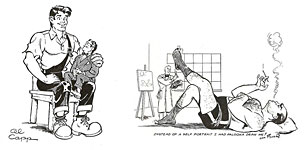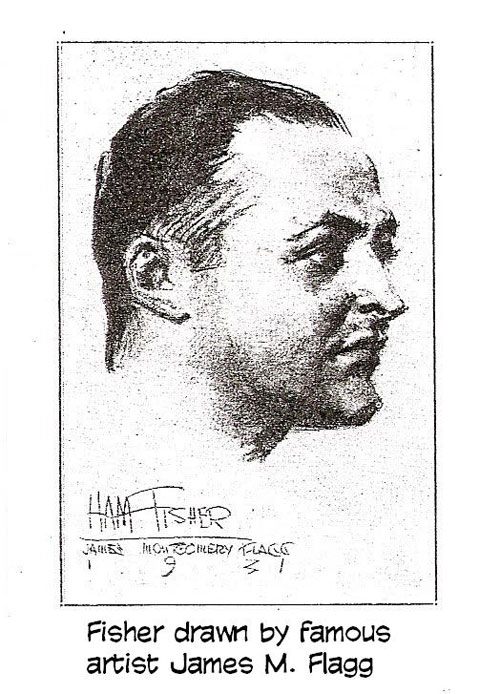HUBRIS AND CHUTZPAH
How Li’l Abner Kayo’d Joe Palooka and Both Their Creators Came to Grief
The story of Al Capp and Ham Fisher, two cartooning geniuses, their rise to celebrity and their furious interaction with each other, is the stuff of epic adventure fiction;
but here, it is fact.
At the peak of their careers in the 1950s, they were superstars:
Capp reached 90 million readers and earned $500,000 a year ($4 million in today's dollars); Fisher, 100 million readers and $550,000 (over $4.5 million in today's dollars).
Their creations were in movies and on stage.
Shamed by his colleagues at the height of his career, Fisher died by his own hand;
Capp died in obscurity, disgraced by the sensational news of
his sexual escapades.
Preamble
HE WASN’T LIMPING: HE WAS LURCHING. He swung his left leg out sideways, almost dragging it forward for each step, and his stride had a practiced rhythm, a rolling gait punctuated by a profound dip every time he transferred his weight to his left leg, the wooden one. But it wasn’t the lurch that attracted the attention of the man in the limousine so much as it was the sheaf of paper in a blue wrapper that the tottering stroller had tucked under his arm. The man in the limousine was a cartoonist, and he thought he recognized the blue wrapping paper: it was, he believed, the paper his syndicate used to wrap rejected artwork in when returning it to hapless supplicants.
“Pull up alongside that fellow,” the man said to his chauffeur. And he turned to the woman seated next to him and said: “I bet that guy is a cartoonist.”
The subject of this wager, the young man rolling along the sidewalk on Eighth Avenue near Columbus Circle, was a somewhat shabby specimen, who, despite the chill of the spring day, was hatless and nearly coatless. But he didn’t need a hat: he had a shaggy mop of thick black hair. He had been in New York only a few weeks, and the six dollars he’d arrived with had long since evaporated. If it hadn’t been for the kindness of his landlady, whose boundless faith in her tenant’s artistic skill prompted her to stake him to his assault on the citadels of the mass media, he would have been back in his native Boston. She let him stay in her attic without paying and even gave him a little money every day for food.
He noticed the limousine slowing down as it pulled alongside him, and he watched as the rear window rolled down, and he saw the man in the back, seated next to a well-dressed woman. The man looked at him and said:
“I’ve bet my sister that you’re a cartoonist. Are you?”
He was. Or, rather, that’s what Alfred G. Caplin aspired to be that spring of 1933. And he had even sold a few cartoons from time to time, both in New York and in Boston. The year before, he had been in New York drawing a syndicated cartoon feature about a pompous young blowhard, but his heart hadn’t been in it, so he gave it up and returned to Boston and his new wife. And now, six months later, he was back in the Big Apple for another try at fame and fortune. It wasn’t a good time to be looking. The nation was firmly in the grip of what would later be called “the Great Depression.” Nationwide, fourteen million were out of work. In New York, 82 breadlines filled a million jobless bellies, but 29 New Yorkers would die of starvation that year. So when the man in the limousine offered him ten dollars to do some drawing for him, Caplin took him up on it.
And that’s how Al Capp, as he would later sign himself, met Ham Fisher, who, in the spring of 1933, was the famed creator of Joe Palooka, a comic strip about a somewhat simple-minded prize fighter who had, by accident, become the heavyweight champion of the world. It was a fateful encounter, as fraught with impending event as anything in the cliffhanging comic strips of the day’s newspapers. Capp earned his ten bucks by finishing a Sunday Palooka, and he performed well enough that Fisher hired him as his assistant at $22.50 a week. Or thereabouts. Capp did the Sunday strips, and within a few months, he was writing as well as drawing the them. But before the year was out, he would leave Fisher to devote his energies to creating his own comic strip, and in the summer of 1934, he, too, became a syndicated cartoonist with the debut of Li’l Abner. He would become as famous and feted as Fisher.
Two giants in their field, and yet when they came together, each was brought low, undone, by the same lie. And then each would destroy himself. And in their self-destruction, they would share a star-crossed fate as surely as if joined at the hip on the day they met on Eighth Avenue near Columbus Circle.
Chapter One
HAM FISHER IS THE MOST CELEBRATED CARTOONIST ever to have been drummed out of the National Cartoonists Society. He may not be the only cartoonist to be so defrocked. But his is surely the most famous case in the annals of the Society. His exit was noisy. For a brief while. And then, all fell silent.
Fisher was dead. He committed suicide within a year of the disgrace of his banishment. His name hasn’t been mentioned much since. And the silence is only one of the strange elements in this ignoble episode.
It was the notorious feud between Fisher and Capp that precipitated events resulting in Fisher’s ouster from the ranks of the Society. The story of the feud is juicy with the sort of morbid sensation that enlivens supermarket tabloids— vicarious sex, scandalous accusation, denials and attempted cover-ups, high dudgeon, and low humor. And the aforementioned disgrace and death. But there is high drama in the tale, too, in the impulse to self-destruction. And there are also contradictory aspects in the traditional rehearsal of the story, puzzles never quite solved. So it seemed to me a story worth exhumation, one of those legends that begs for careful inspection.
I didn’t always hold this conviction. But several years ago, sometime in the 1990s, I met cartoonist Morris Weiss, and over dinner with Weiss and his wife Blanche at a little place near his home in Florida, he started talking about the various places the path of his career had crossed the path of Ham Fisher’s. Weiss speaks with an admirable precision, clipping his words into a lilting syntax as he goes. No, he said in answer to my question, he didn’t think of himself as a particular friend of Fisher’s. Fisher was not a nice man, he said. Not the sort of man you’d be the friend of. But Fisher hadn’t been treated fairly, Weiss said.
My curiosity piqued, I decided to look into the sordid tale of the feud between Fisher and Capp. And when I did—when I picked up the puzzles that lay around and looked at them closely—I found in the contradictions truths that, it seemed to me, had long been overlooked.
Morris Weiss’s connection with Fisher, an admittedly tangential one, began early and ran late. Weiss spent most of his cartooning career with one or the other of two newspaper comic strips, Mickey Finn and Joe Palooka. Joe Palooka was Ham Fisher’s creation, but Weiss didn’t work on the strip with Fisher. By the time Weiss arrived at the strip, Fisher had been dead for years.
At the age of nineteen, Weiss entered the profession by lettering Ed Wheelan’s Minute Movies. After similar stints on with Pedro Llanuza on Joe Jinks and with Harold Knerr on The Katzenjammer Kids, Weiss began assisting Lank Leonard in 1936 just as the latter launched Mickey Finn, a strip about a kindly young work-a-day policeman and his Irish family. Following service in the Army in World War II, Weiss resumed his career by doing comic books for Stan Lee at Timely. Then in 1960, Weiss rejoined Leonard, eventually taking over Mickey Finn in 1968 and continuing the strip until it ceased in 1977. For about the same period, he also wrote Joe Palooka, which was then being drawn by Tony DiPreta, who would draw the strip until it ended November 4, 1984.
While still a teenager attending the High School of Commerce in New York City, Weiss visited many cartoonists in their studios, seeking advice about how to enter the profession. Among those he visited was Ham Fisher. It was about 1932 or 1933, very early in the run of Joe Palooka, and Fisher had an apartment in the Parc Vendome, a posh apartment building in Manhattan.
“Ham had moved into the Parc Vendome to live in the same building with James Montgomery Flagg,” Weiss told me. “Ham was very much conscious of celebrities; he wanted to meet the celebrities and mingle with them. So he befriended Flagg and moved into the same apartment house as he lived in. Ham was very nice when I saw him back then. He gave me a drawing. And then I didn’t see him until many years later.”
The next time Weiss encountered Fisher was in 1944, when Weiss was in the Army and home in New York on furlough. “I dropped in at the McNaught Syndicate [which distributed Mickey Finn as well as Joe Palooka] for some reason or other, and Ham was there, and we left together and shared a cab to where he was going. I recall he was telling the cabbie stories of the things he was doing for the soldiers through the comic strip and with chalktalks in hospitals and things like that. And when the cabbie heard everything Ham had to say—apparently the cabbie was already a veteran, and he started to tell Ham stories about his army life, and at that point, Ham lost interest.”
Clearly, Weiss implied, Fisher was too wrapped up in himself to listen to anyone else’s life story. At this time in his career, Fisher was a national celebrity of “Roman self-esteem,” as Time put it (November 6, 1950; 77), and around New York City, he was a well-known denizen of fashionable night life. “He lived like a lord,” writes Jay Maeder in “Fisher’s End,” published in Hogan’s Alley no.8 (Fall 2000), “and he always had the best seats at the races and the prizefights and the musicals, and he played golf with Bing Crosby and boasted about it” (92).
Fisher was widely-known and liked in the sporting world. He watched every notable prize fight from the press box, and the fans were reportedly as eager to see him as they were to see the fight. He was welcome in every training camp and fight gym. He was a member of the Boxing Writers Association, and he spent much of his time outside his studio at training camps, “picking up ring color and even sparing with the fighters,” reported Newsweek (December 12, 1939; clipping, n.p.).
Joe
Palooka was without
question one of the most popular comic strips of the period. Depicting the
adventures of a good-hearted if somewhat simple-minded prize fighter
(ostensibly, the world’s heavyweight champion), the strip consistently placed
among the top five comic strips in readership surveys in the forties and early
fifties. According to a 1950 report in Time, Fisher’s strip was right
up there with Blondie, Little Orphan Annie, Dick Tracy,
and Li’l Abner (clipping, n.d., n.p.).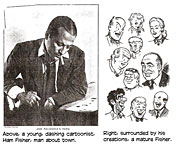
Fisher told action-oriented adventure stories, full of exotic incident as well as a healthy dose of humor. And he was expert at prolonging the agonies he inflicted upon his characters, creating suspense-filled storylines the equal of any contrived by his cohorts in the cliffhanger game. His cast included Joe’s long-suffering and voluble manager, Knobby Walsh, who loves Joe but has an eye always on gate receipts, too. Reportedly a blend of the personalities of several prominent fight personalities, notably Jack Bulger (once handler of Mickey Walker) and Doc Kearns (Jack Dempsey’s manager) and Tom Quigley (a Wilkes-Barre boxing promoter), Knobby is often supposed to be Fisher’s alter ego in the strip, a supposition Fisher himself fostered. The other principal character is Joe’s fiancé, the beauteous blonde Ann Howe, whom the champ finally marries on June 24, 1949, after an eighteen-year engagement. (It was in the air. Dick Tracy married Tess Trueheart on Christmas Eve, 1949; and Li’l Abner married Daisy Mae on March 29, 1952.) To this group, Fisher added redheaded Jerry Leemy, Joe’s excitable wartime Army buddy, and, later, the hugely comic heavyweight, Humphrey Pennyworth, a 300-pound village blacksmith with a heart of gold who is probably the only person who we are certain could defeat Palooka in the ring, and, later still, the homeless waif Max, a diminutive monument to unadulterated (which is to say cloying) sweetness, always attired in cast-off shoes too large for him and wearing an out-sized hat. The inspiration for Max, according to William C. Kashatus in Pennsylvania Heritage (Spring 2000), was Max Bartikowsky, a kid who lived in Fisher’s old Wilkes-Barre neighborhood who would sometimes dress up in his mother’s floppy hats and his father’s big shoes and go running up and down the street. Said Bartikowsky: “I guess that left an impression with Fisher” (28).
As for Joe himself, it isn’t quite accurate to say he is simple-minded. But how else do you describe such an uncomplicated character?
To begin with, he’s big and strong. He is, after all, a professional boxer. His shoulders are broader than anyone else’s in the strip. Except those of his opponents in the ring. He’s also entirely, doggedly, wholesome. He’s thoughtful, compassionate, and completely loyal. And humble, relentlessly humble. He embodies clean living, clean talking, and clean thinking, not to mention honesty, courage, tolerance, and devotion to duty, country, mother, and apple pie. You see what I mean by “uncomplicated”?
Even his face is uncomplicated: it’s absolutely plain, completely open and unassuming. Manly lantern jaw, tiny nose, gigantic shock of forelock, wide-open eyes. It’s the sort of face you expect on a man incapable of dissembling. Or of compromise. Or of anything mean, small, or even remotely unkind. With Joe Palooka, what you see is what you get. Simply stated, he is an ideal. An American ideal of manhood. Or of knighthood, for that is what he is—a kindly, gracious knight, righter of wrongs, defender of truth, beauty, justice, and the American way.
While the artwork in Palooka is distinctive and well done, it isn’t of the caliber of Alex Raymond or Hal Foster or Milton Caniff in Flash Gordon, Prince Valiant or Terry and the Pirates. It’s the stories rather than the artwork that grip and hold the reader of Fisher’s strip. There are, for example, plenty of boxing matches, and Fisher made engrossing stories out of them. Fisher’s sequences in the boxing ring are enthralling to witness. They are skillfully and realistically choreographed, every move carefully plotted. And every move that is depicted is given significance in the story, too; no wasted motions here. Every picture is accompanied by a “voice over” narrative—the voice of a radio announcer describing to his audience what he sees. In those golden days of yesteryear before television, we “watched” such athletic contests as boxing matches through the eyes of a radio announcer. So Fisher’s device enhanced the illusion of reality in the strip.
Here’s the announcer in a sequence in 1938: “Everyone is expecting Palooka to come out in the second [round] and kayo Red Rodney ... there’s the bell ... Palooka jabbed but missed Rodney, who retaliated with a beautiful left hook to the side of Palooka’s head ... Palooka danced away ... they’re sparring now. ...”
It’s Joe’s first fight against a left-hander, and he’s baffled by what his opponent does with his left hand. The announcer explains the problem as he describes the action:
“Palooka
can’t seem to evade that terrible left of Rodney’s,” the announcer says, the
picture showing Rodney landing a left hook that staggers the champ. And
then—“Palooka has changed his stance ... he’s leading with his right, southpaw
style. Will it work?” Next caption: “It didn’t ... Red feinted Joe and then
whipped in a fierce left hook. Palooka has lost every round so far.”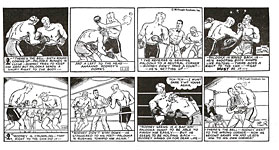
The fight goes on for two weeks. It was a typical Fisher performance: the fights were always deliciously long, every pugilistic nuance lovingly attended to. Finally, Joe figures out how to fight the left-hander: while in a clinch, he notices that Rodney’s left isn’t any good at short range. Joe moves in close:
“Rodney tried to spar him off but Palooka crowded him ... there’s a right to Rodney’s breadbasket ... and a left ... wow! ... it caught Red on the cheek ... he’s down ... Rodney’s on one knee ... the count is six—but there’s the bell—the round’s over.”
In Joe’s corner, his trainer marvels: “Dawggone—whut did yo’ do?”
“It’s simple,” Joe says. “I foun’ out that crowdin’ ’im dint give ’im a chanct t’ use a left—then I started usin’ a straight right.”
Joe talks like that. And his language reveals his humble nature. Fisher’s homely locutions, the merciless contractions that infest his hero’s utterances, suggest a soft-spoken manner of address. And that, in turn, reflects Joe’s essential humility, his “just folks” origins, his redeeming lack of sophistication, his wholly unpretentious personality.
There’s nothing “elegunt” (as Fisher would have him say) about his speech. He says things like: “Kin ya ’magine?” “Honist.” “I been insalted.” “I wish I could go somewheres and jist be fergot.” And when he’s excited, “Tch, tch”—his most fervent expletive. And, always a model of good manners, “Than-kyou.”
Throughout his run on the strip, Fisher reflected the beliefs of his audience. Joe Palooka was, above all else, a sentimental strip. But it was unabashed, traditional American sentiment, born and bred in the custom and aspiration of the American spirit. Its raw sentimentality may undermine our interest these days; but during the years of World War II—and for a period both before and after—the strip was in perfect step with the times. Coulton Waugh, whose venerable 1947 work The Comics successfully shaped comics criticism for decades, says this about Fisher’s strip:
The great quality that lifts the strip to the very top is simply the heart in it, the human love. All people ... know that it is love that makes men rank above the brutes, but it is exceedingly difficult to write about or speak of this precious business without assuming the righteous attitude, the smallest hint of which sends the public scampering. ... In this respect, Ham Fisher resembles Milton Caniff: neither spoils his work with preachiness.
Things just happen in the life of Joe Palooka; he doesn’t go out of his way to be good, it’s just in him. He reacts with greatness because he can’t help it. ... Simple people [took] as an ideal the big, graceful guy with thunder in his fist and with humility in his heart. ... He was one of them (283).
Year after year, Fisher told a riveting story. And his stories gave his readers something to admire, to emulate. And so why don’t we hear more about Ham Fisher and Joe Palooka in these days of revived interest in the cultural artifacts of newspaper comic strips in their Golden Age?
True, the strip’s often cloying mawkishness makes it a little less than congenial reading nowadays in the culturally sophisticated 21st Century. But there’s more to it than that. There’s also Ham Fisher himself. And to understand the near disappearance of Joe Palooka from the pantheon of comic strip greats, we have to know something more about Ham Fisher.
Chapter Two
HAMMOND EDWARD FISHER BECAME A CARTOONIST against all odds. All the odds that swayed fate anyway. Born September 24,1900 (or 1901) in Wilkes-Barre, Pennsylvania, the son of a Jewish scrapyard dealer, Fisher, to hear him tell it, surmounted the most formidable obstacle any cartoonist could have faced:
I was five years of age when I declared that I was going to do a comic strip and no amount of frustrating circumstances ever deviated me from my course. My course was set, and though I encountered many more than my share of storms, I was determined to find a harbor one day: a drawing board, a bottle of India ink, a goodly supply of Strathmore, plenty of 290 pens and—a deadline.
[But] my father objected strenuously and I could spell strenuously “s-t-r-a-p”! He despised my ambition. He wanted me to be a businessman, hence his disgust at my aesthetic taste. I wasn’t allowed to draw a picture in the house. I hid in the attic behind boxes and trunks to copy the pen lines of James Montgomery Flagg or study the composition of the great [Clare] Briggs or H.T Webster.
Young Ham was saved by his mother, as he concludes the foregoing description of his birthright in an autobiographical essay in Number 4 of a 1954 correspondence course, Illustrating and Cartooning, from Art Instruction, Inc. of Minneapolis, Minnesota:
My mother was a very literate woman and our house was filled with fine books, good paintings and the wonderful illustrations of Gustave Dore and Sir John Tenniel. These were my Heaven (5).
Ham was
focused so exclusively on drawing that he “was thrown out of every class in
school for paying no attention.” Once Fisher was safely launched on his Joe
Palooka career and the accompanying speaking tours, he enlisted a friend,
Anne Parenteau, to write a biography to be used by newspapers in promoting his
appearances.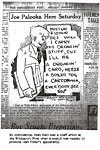 She,
quoted by the Bridgeport (Connecticut) Post to publicize Fisher’s
talk there in August 1931, continues his life story:
She,
quoted by the Bridgeport (Connecticut) Post to publicize Fisher’s
talk there in August 1931, continues his life story:
He graduated from high school in a class by himself. No one else came so close to being left [behind] as he did, so they put him in a class by himself. ... After graduation, Ham went to college for two weeks. They were two marvelous weeks spent principally in cabarets (clipping, August 20, 1931; n.p.).
Then he returned home to drive a truck for his father until the family business failed soon thereafter. He worked as a salesman for a time and then embarked upon a military career during the First World War, but, Parenteau noted, it was as short-lived as his college career had been:
The war and Ham’s first love affair both hit him at one swoop. He went to Camp Lee in Virginia and arrived at the same time that the Armistice did. This was a terrible disappointment because he had always wanted to be a hero and felt that he had lost his great opportunity to “show” before his lady love. But he got over the love affair and the disappointment and at the age of 20 got his first newspaper job as cartoonist and roving reporter for the Wilkes-Barre Record.
In his own account of his life, Fisher was profuse in thanking “a good and gracious God for letting me be on my way at last.” He produced a daily column (“Cousin Ham’s Corner”) with caricatures of local celebrities and drew a cartoon or two, sports or political. After a year, he left the Record to join the staff of the city’s other paper, the Times-Leader, he explained—:
because they let me put my name bigger on the cartoon. That’s a fact. All we cartoonists are hams and my name especially fits me. But boy, it was great. I was a personage in our city. If I hadn’t been a cartoonist do you think that judges, mayors, the governor—well, in fact everybody—would have sought me out? I had a position of influence and power, but not too much affluence. Soon I was toast-mastering at banquets, getting good money as an after dinner speaker with nice little political plums thrown my way (6).
He confessed that he even drew political cartoons for both the Democrat and Republican parties. And then, he said, “came a mistake.” He joined a friend in launching a new newspaper. It lasted only about a year, but its collapse (due to the effects of a strike in the local industry, coal mining) was undoubtedly a blessing in disguise for Fisher. A couple of years before, in about 1920, he had been smitten with an idea for a comic strip, and if the newspaper had succeeded, his comic strip might never have germinated, and the pugilistic world would have been poorer.
In his autobiographical essay, Fisher recounts the moment of inspiration that is part of the Fisher legend:
One day, while passing around the public square in Wilkes-Barre, I saw a chap whom I knew well. He was a boxer with very light blond hair which persisted in sticking straight up in the air—sort of a crew haircut without the haircut. His name was Joe [Hardy], and I knew him as a very nice guy with a lethal right hand; in other words, he was a hunk of TNT in the ring and as nice a gentleman outside the squared circle as I have ever known.
As I approached him, he noticed me and greeted me with “Hi, Ham! Hey, why don’ I an’ youse have a game of golluf at the new Muneesippal Golluf Stadium?”
I give you my word, a bolt of lightning stuck me. Within an infinitesimal part of a second I knew I had what I had prayed for all my life: the idea for my comic strip,
something out of the ordinary, the saga of a real American boy whose life gave him an opportunity for high adventure and uncommon experience. No humdrum existence, his, and I knew what he would be—he would be all the things I wished I could be, a fighter for the worthwhile things democracy teaches, a clean living champion of democracy. He would be unbeatable in physical combat, the sport of prize fighting to which fate had directed him through Knobby Walsh, his first employer, and outside of the ring he would be a gentle knight, courteous and kind, with a deep conviction of democratic principles (7).
Even Fisher admitted in the next sentence that not all of Joe Palooka came to him in that “infinitesimal part of a second.” He was writing in 1953 with the benefit of 23 years of the strip’s growth and development behind him. His description of his “gentle knight” was of Joe Palooka in 1953, not at the moment of inspiration in the early 1920s. At that moment, Fisher was envisioning a good if somewhat stupid youth whom he called Joe Dumbelletski at first when he wrote and drew the inaugural three weeks of the strip that day, back at the offices of the Times-Leader. But Fisher’s brain child didn’t see print until 1930, and by then Joe had a new last name: “palooka,” a term often used to describe a less-than-distinguished athlete, especially a prizefighter. In Joe’s case, it would be an ironic name choice. The story of the launching of Joe Palooka is another of cartooning’s legends.
Fisher went to New York in the early 1920s to sell his strip but no syndicate was interested. For the rest of the decade, Fisher kept trying, going back and forth from Wilkes-Barre (where he’d rejoined the Times-Leader after the demise of his newspaper venture) to New York. In 1927, he stayed in New York working in the advertising department of the New York Daily News. All the while, he kept peddling Palooka.
Finally, he ran into Charles McAdam, general manager of McNaught Syndicate, who promised to give Palooka a try the next year. Fisher insisted on going out himself to sell his strip to newspaper editors. To prove his ability as a salesman, he undertook to sell one of McNaught’s losers, Dixie Dugan, a strip about a would-be show girl. It had been offered around before but only two papers had bought it. Paying his own expenses, Fisher went on the road and sold the strip to thirty-nine papers in forty days.
“It was the biggest sales record in syndicate history,” Fisher claimed later in his autobiographical essay, continuing—:
Boy, I was in solid. I hadn’t cost the syndicate a dime of expense. My commissions ran into huge figures, and I was flattered all over the lot. Charley and I became great pals (he’s still my best friend), and he bragged that he had the best salesman in the country. I hadn’t told him that every editor and publisher I had seen had been given a promise by me that I’d bring back the greatest feature they’d ever seen, and I’d give them first crack at it.
When I told Charley I was now going to take Palooka out, he told me I was crazy. Why do that, when I had a great future already assured as syndicate salesman. McAdam went away on a long trip to the tropics, and I started out with Palooka. Just as I started, the market crash rocked the country. Business went to the dogs. Syndicates were swamped with cancellations. Editors called me an idiot for daring to try to sell an new feature. But in spite of the fact that this was the most terrible of all financial panics, I sold Palooka to twenty-four leading papers in as many cities in eighteen days (8).
Or maybe it was just twenty papers in three weeks. Or eighteen in 22 days. Or maybe it was 22 papers in 18 days. Or 30 in three-and-a-half weeks. The numbers, as is their wont in legends, change from one telling to the next. In any case, Fisher’s strip was at last nationally syndicated. It was 1930; Joe Palooka had been gestating for nearly ten years.
In The Adventurous Decade, Ron Goulart reveals something of the secret of Fisher’s success as a salesman. He quotes from the autobiography of Emile Gauvreau, editor of the New York Graphic before becoming editor of William Randolph Hearst’s New York Mirror: “I bought my last comic strip one New Year’s Eve when Ham Fisher ... befuddled me with a rare bottle of bourbon during a hilarious celebration. When I woke the next day, I found I was sponsor of Joe Palooka, an exemplary character who never drank or smoked and was good to his mother” (166-67).
According to Weiss, Fisher was a success as a salesman because his behavior was so outrageously ingratiating that a customer would buy his product just to get him out of the office.
Weiss told me the story of how Fisher “got to” Charles McAdam:
Lank Leonard told me this. He was with the George Matthew Adams Syndicate when he was a sports cartoonist, and Ham Fisher went to the George Matthew Adams Syndicate and he saw Frank Marky. Frank Marky was a top syndicate salesman. He had been one of the top salesman for the Chicago Tribune Syndicate; and now he was the top salesman for the George Matthew Adams Syndicate. And Ham went and saw Marky and tried to sell him the Joe Palooka strip. And Fisher was all over him, telling him how great he was and so on. Marky never saw any human dynamo to equal Ham Fisher trying to sell him Joe Palooka.
So Marky said, “I tell you what I want you to do: I want you to go over the McNaught syndicate and see Charlie McAdam, and I’ll call McAdam and tell him to see you.”
And Ham said, “Not the great Charles V. McAdam?”
“Yes, and he’ll see you”
And Ham left.
When he left, Marky called up McAdam and said, “I want you to see this character who’s coming in with a comic strip, Ham Fisher. The comic strip is nothing but you’ve never in your life seen a character like this; I want you to see him.”
Ham went in and saw McAdam, and he was all over him— on the desk, over his shoulder. And finally, McAdam said:
“Now I want you to sit in that chair and stop jumping up and down. Look,” he said, “this comic strip, this fighter, stinks. Nothing there. But I want you to go out and sell some features for me. I’m giving you expense money. But don’t use my expense money to sell this piece of garbage of yours.”
And when Ham left, a couple of guys came in and said, “What was that tornado that just blew in?”
And McAdam said, “Listen, they’re going to buy his features just to get the guy the hell out of the office.”
Joe first appeared
on April 21, 1930: he walks into a Wilkes-Barre haberdashery run by Knobby
Walsh, looking for work. Knobby hires him, but one afternoon when Knobby’s off
playing cards with his cronies, Joe permits a bunch of local toughs to loot the
store, believing they have charge accounts. Knobby is ruined, but he soon
finds a way for Joe to help him recoup. As it happens, the current heavyweight
champion comes to town, and his manager puts out the word that he’s looking for
someone to fight in an exhibition contest for $200. Knobby talks Joe into
doing it. Joe, who knows nothing about boxing, takes a drubbing for the first
four rounds, but then, when Knobby tells him that his opponent was the leader
of the looters, Joe is enraged. He charges out at the other fighter, yelling,
“You un-honist crook!” He floors him with a single blow and finds himself the
heavyweight champion.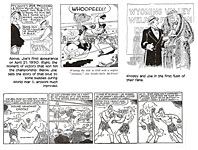
Boxing was a popular sport in the 1930s and 1940s, and Joe Palooka was popular in consequence. Fisher soon found himself something of a celebrity. Before long, he was hobnobbing with stellar figures in sports and in other arenas of public life. As Robert H. Doyle notes in “A Champ for All Time” in Sports Illustrated (April 19, 1965), these personages Fisher often drew into the strip in cameo appearances ring-side during one of Joe’s fights—boxers Jack Dempsey and Gene Tunney; politicos “Big Jim” Farley and New York’s one-time “midnight mayor” of the jazz age, Jimmy Walker; Walker’s idiosyncratically stalwart successor, Fiorello LaGuardia; movie stars like Clark Gable, Bing Crosby, and Claudette Colbert. Occasionally, a regular character in the strip would be modeled on someone in real life ... [such as] rotund Humphrey Pennyworth, for whom Toots Shor is supposed to have served as inspiration” (126).
Among the famous people Fisher cultivated was one of the most celebrated and flamboyant illustrators of the age, James Montgomery Flagg. A neighbor in the same apartment building, the cartoonist was Flagg’s frequent visitor and companion. Why a man of Flagg’s sophistication and talent would tolerate—nay, even enjoy—the company of a man of Fisher’s comparatively limited social and artistic abilities is something of a puzzle. Perhaps, as Weiss suggested to me, Flagg enjoyed having a herald, someone to precede him into restaurants and announce his coming to maitre d’s and managers.
Capitalizing on the public’s interest in boxing, Fisher imbued his stories with realistic touches. He spent as much energy in the strip building up to a big fight as real-life promoters did for real-life contests. And Joe’s training camp reeked of authenticity. But all the realism created a problem. Fisher’s cartooning ability was of the big-foot comedic school. His skill was on a par with many of his contemporaries—Sidney Smith, for instance, Harold Gray; even some of the early work of Chester Gould. But that kind of primitive realism couldn’t create the aura that presumably Fisher was now seeking. So Fisher did what many cartoonists did then (and still do): he hired an artist more talented than he to do the drawing. The first of these (and the one with the longest tenure on the strip) was another Wilkes-Barre refugee, Phil Boyle.
Because so much of the run of the strip was ghosted by others, rumors persist in the cartooning community (particularly, as Goulart reports, among older cartoonists) that Fisher
never drew the strip: even the sample strips that launched the feature, according to this tradition, were drawn by a ghost (a highschool student, so the story goes). I suspect not, but it is true—without cavil or question—that most of the years of Joe Palooka were drawn by others.
Moe Leff was one of the ghosts. In the introduction to Clark’s Classic Comic Strips Joe Palooka volume, “A Ticket to Palookaville,” Ron Goulart says that Fisher hired Leff away from Al Capp in the mid-thirties, speculating that this maneuver gave Capp “yet another reason to loathe Fisher” (12).
Leff was the principal graphic force in Joe Palooka for about twenty years. And Fisher was effusive in acknowledging his debt to Leff and Boyle. “It would be impossible to do the job without the magnificent assistance of the two great guys who help me, Phil Boyle and Moe Leff,” he wrote in his 1954 autobiographical essay. “Both of them are the very tops as artists, and Leff, especially, is a bundle of TNT who is capable of doing as great a strip as any man in the business. I’m a lucky guy to have found these two whizzes. We work as a team on every phase of the many facets of what today is a vast enterprise. And I’m ashamed to say,” he added in an earlier, much more widely circulated article for Collier’s (October 16, 1948), “they usually sit in the background while I take the bows” (28).
According to the Fisher legend, Fisher always drew the faces of Joe and Knobby; Leff left blank ovals on the illustration board, and Fisher deftly filled them in. Considering that the faces of Joe and Knobby were rendered very simply compared to the visages of other characters in the strip, this contention is probably true.
Another of Fisher’s assistants, for a short time in 1933, was, as we’ve said, Al Capp.
Chapter Three
AL CAPP WAS
BORN ALFRED GERALD CAPLIN on September 28, 1909, in New Haven, Connecticut, of
East European Jewish heritage. His parents had come from Latvia to New Haven in
the 1880s. “My mother and father had been brought to this country from Russia
when they were infants,” Capp wrote in 1978 (quoted in Wikipedia). “Their
fathers had found that the great promise of America was true—that it was no
crime to be a Jew.” Alfred was the eldest son of Otto Caplin, a chronically
unsuccessful salesman, and Matilda Davidson, a woman with a fierce survivor
instinct who shepherded her family through a persistently penurious existence.
William Furlong explains how (in The Saturday Evening Post, Winter 1971):
“She tutored her children in the techniques of living on nothing at
all—wheedling stale bread from bakers, refusing to deal with grocers who
wouldn’t hire one of her sons, leading the children on rubbish raids that might
turn up a few usable items of clothing or even an unused piece of coal” (45).
Whenever she ran out of rent money, the family moved, first to Bridgeport and
then from one rented house to another in Boston.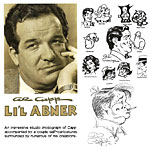
As a child, Capp (the pen name he adopted as his legal name in 1949) had been a prodigious reader. He'd read Joseph Conrad, Anthony Trollope, Charles Dickens, and all of Shakespeare. And he'd read all of Bem,rnard Shaw—at the age of thirteen. He'd done a lot of reading during his youth because he couldn't be physically active. He'd lost his left leg when he was almost nine. One hot afternoon in August 1918, he'd hopped a horse-drawn ice wagon to pinch a shard of ice. A trolley car was only a few feet behind the ice wagon when Capp jumped off, stumbled, and fell under the streetcar's wheels. "When they took me to the hospital," he recalled, "I had no identification and so they roused me and I looked at the leg, and it was a mess—like scrambled eggs. There was just nothing that you could call a 'leg' left of it." They amputated above the knee.
After that, Capp hobbled along on crutches until he was fitted with an artificial leg. But his father, working mostly as a traveling salesman, couldn't afford to replace the leg often enough to keep pace with his son's growth. For most of his youth, Capp's wooden leg was too short, and he'd never learned to walk properly. He limped more pronouncedly than many people with artificial limbs. But he didn't complain; nor did he want sympathy.
When he wasn't reading as a kid, Capp was drawing. His father, who had trained to be a lawyer, was something of an artist, and his drawings for his family's amusement inspired his son.
“My father’s real talent was drawing,” Capp said in Furlong’s article. “He was a most naturally gifted comic artist. I grew up watching my father do comic strips on brown paper bags with my mother and himself as the two principal characters. He always triumphed over her in those strips. But only in them. Never in real life” (45).
When he was twelve, Capp read about Bud Fisher making $4,000 a week drawing Mutt and Jeff, and he decided forthwith to become a cartoonist. And in Brooklyn, to which the family moved for six months about that time, he sold his first drawings. In Cartoonist Profiles, no. 48 (December 1980), his brother Elliott tells the story of Al’s career in school:
They put him in a class of retarded children because he wasn’t normal—he was a “cripple” in the school’s parlance; he had only one leg. Of course, it was a brutal class with a bunch of real young criminals, and the only way he could survive in this terrible, physically-threatening atmosphere, was through his talent: he drew pictures. So instead of beating him up, they began to admire him and request drawings. Mostly they wanted pictures of their teacher—nude! So he survived because he could draw Miss Mendelsohn nude (81).
Capp charged twenty-five cents a piece for the pictures. But when he retold the story in his memoirs, My Well Balanced Life on a Wooden Leg, he left out the part about being in a class for retarded children. In his memory, the entire student body of P.S. 62 in the Brownsville “(or Murder, Inc.)” section of Brooklyn consisted of the retarded—“subnormals, petty thieves, rapists and thugs,” he said (19). Miss Mendelsohn became Miss Mandelbaum, and because she taught drawing, she recognized young Capp’s talent “and showed great interest in my work, coming in every day, bending over my desk to watch me draw and coaching me as I went along. My classmates showed a great interest in Miss Mandelbaum’s coaching, mainly because of what happened to her neckline when she bent over to coach me” (25).
One day when Miss Mandelbaum realized what kinds of pictures her protégé was making of her, Capp said, “she screamed a terrible scream of anguish and betrayal ... and ran out of the room. She never came back. My father’s business [in Brooklyn] failed, we moved back to Massachusetts, and my career as a professional artist didn’t get going again for ten years” (28). In Capp’s retelling, he was drawing Miss Mendelbaum in a one-piece bathing suit, not in the nude.
As a teenager, Capp often absented himself from the family hearth to wander off into unexplored climes. “At 13 or 14,” his brother Elliott wrote in the 1980 Cartoonist Profiles article, “he’d take off with his friends for Atlantic City or for Vermont” (81). One summer, after telling his mother he was going out to get a pack of cigarettes, he disappeared for two weeks. Thumbing a ride to the store, Al and a friend stopped a car the driver of which said he was going to Memphis, Tennessee. The boys promptly changed their plans: they, too, they said, were going to Memphis. And they did. By a less than direct route.
In Memphis, they stayed with Al’s Uncle George Baccarat, an orthodox rabbi, for a few days, until, as Elliott described it in his Al Capp Remembered, they managed to outrage the relatives with “their quaint toilet habits and relentless pursuit of the daughters of Uncle George’s parishioners” (63).
En route to Memphis, the youths passed through the Cumberland Mountains, and Al encountered his first hillbillies, an experience he later said inspired his creation of Li’l Abner, exaggerating the simplicity of the hill folk into a burlesque masterpiece. The hillbilly encounter, Elliott delicately implied, was part of the Li’l Abner “mythology”: “After the strip had become a success, Alfred felt that it needed a historian as the Trojan War needed a historian. And Alfred become his own Homer.”
Following an incomplete highschool career distinguished mostly by his truancy, Capp entered a succession of art schools, including the Pennsylvania Academy of Fine Arts, the Boston Museum School of Fine Arts, and the Designers Art School, where he met Catherine Wingate Cameron, whom he married in 1932. Explaining the litany of art schools, Capp joked that since he couldn't afford tuition, he left them one after the other when the bills came due.
At the end of this parade of art courses, Capp decided to assault the citadel of professional cartooning: he went to New York, capital of cartooning in the U.S. He eeked out a living for a while by selling advertising cartoons, but he also prevailed upon another uncle, Harry Resnick, an agent of sorts, to help him find something better. Resnick called the Associated Press and asked if someone would look at his nephew's drawings. The editor of AP’s feature service, Wilson Hicks, looked, and a short while later, he called Capp and gave him Colonel Gilfeather, a panel cartoon continuity that had been staggering along under the rather clumsy pen of Dick Dorgan. Dorgan was the younger brother of the legendary "TAD," who had made comic capital from his "low life connections."
Thomas Aloysious Dorgan, who signed his cartoons with his initials and thereby rechristened himself, had come to New York from San Francisco in 1907. He drew sports cartoons for Hearst, but he prowled backstages, streets, alleys, poolrooms, all-night beaneries, and gyms in his search for raw material. And "raw" it was for much of proper society: anyone who engaged in professional sports, from baseball players to boxers, jockeys to gamblers, sports writers to cartoonists, was regarded with disdain. If the sports pages tainted the comics—because so many of them originated in that section of the paper—TAD helped remove the taint by making people flock to his banner, eagerly looking for a chuckle. He turned aloof disdain into comradely laughter with his cartoons.
He also enriched the language by popularizing the slang of those who haunted his haunts—even minting a few new coins of phrase himself whenever he sensed a needy void in the lexicon. A drunk was a "barfly" to TAD; eggs were "cackle berries"; eye glasses, "cheaters." A restaurant was a "beanery" or a "one-arm joint," and by the same token, waitressing was "dealing off the arm." In cartoons with titles like Indoor Sports and Outdoor Sports, TAD perpetuated that breed of conversational panel cartoon in which hangers-on in the background comment, often derisively but always with comic results, on the foreground action, a format started by Clare Briggs and H.T. Webster and subsequently perpetuated by Jimmy Hatlo. And by Gene Ahern in Our Boarding House, which now TAD's brother aped in Colonel Gilfeather, a reincarnation of Ahern’s blowhard protagonist, Major Hoople. Dick Dorgan, however, did not have his brother's gift, and Hicks felt Gilfeather was failing and needed new blood. Al Capp would supply the transfusion.
Capp came to New York in the early spring of 1932 and confronted Gilfeather. It was not a felicitous encounter. His stewardship on the feature was, as it proved, a doomed undertaking. Capp was struggling to master his craft, and he had to start by imitating Dorgan. The idea was to make the shift gradually from Dorgan's style to his own. But Capp, as yet, barely had a style. He admired the pen-work of Phil May, a British cartoonist of the late nineteenth century whose economy of line anticipated modern cartoon graphic technique by thirty years. Capp had seen a book of his cartoons in the library. Capp scorned Dorgan's work, and he hated Colonel Gilfeather. Nonetheless, he slaved over it. In an attempt to whip up his interest in the feature, he shifted the focus from Colonel Gilfeather to his younger brother and retitled the cartoon Mister Gilfeather. Gilfeather the Younger was as much a blowhard as his brother, but rather than inventing money-making schemes, he spent most of his energies chasing girls, enjoying a somewhat happier prospect than the Colonel’s.
Capp lived in a succession of what he called “airless rat-hole rooms” in Greenwich Village and stalked the streets every day, reading menus in the windows of restaurants until he found a place he could afford. He was paid $52 a week for Gilfeather, enough to live on in New York, but he sent part of it to his new bride, Catherine. She was living with her parents in Amesbury, Massachusetts, because he had too little money to afford an apartment for them both. Capp kept irregular hours at the AP office, and when he came in, it was usually in the afternoon, and he worked into the evening. That’s when he met Milton Caniff, and the two formed a life-long friendship.
Caniff had just arrived in New York from Columbus, Ohio, and he worked evenings, too, and he got to know Capp very well. "He was a kind of sad sack in those days," Caniff told me. "He could be very difficult if he didn't like you. Not a charming person unless he chose to be." But Milton was charming and sympathetic. He made a good listener.
"In the daytime," Caniff reflected, "we would probably have never spoken a word to each other, but at night we talked. In an empty office like that, you talk about things you wouldn't talk about when other people were there. He and I got along fine right off the bat. I realized he was struggling—to do Gilfeather, to make it.”
By late summer, Capp had had enough. Faced with incompatible material, separated from his new wife and struggling to subsist from day to day, Capp doubtless felt the job wasn't worth the strain. Whatever the case, he quit the AP and went back to Boston, where he studied at the Museum of Fine Arts for several months before returning to give New York another try.
Chapter Four
CAPP RETURNED TO THE BIG APPLE with six bucks in his pocket and had no luck, so when Fisher stopped him that spring day on Eighth Avenue near Columbus Circle (or maybe it was on 42nd Street just outside the Daily News building; legends differ) and offered him a job, Capp eagerly accepted. For several years thereafter, both cartoonists told the same story about their initial meeting, but by 1950 when the feud was bubbling to a boil, there were two versions of that encounter—Fisher’s and Capp’s. Both versions were rehearsed in Maclean’s Magazine (April 1, 1950; clipping, n.p.). Here’s Fisher’s version:
I was driving with my sister Lois when I saw a fellow carrying a roll of paper along the street. He looked unkempt and was limping. I pulled over and said, “What kind of drawings have you in there, buddy?”
“How’d you know they’re drawings?”
“I work at the Mirror and see lots of comic strips come in wrapped in that kind of paper,” I said.
“Nobody’ll buy my drawings. I’m headed for the river,” he said.
I said, “Hop in and we’ll go to my house for lunch.”
His name was Al Capp. I didn’t tell him mine. I asked him, “What’s your favorite strip?” To my delight, he said, “Joe Palooka.”
Capp saw on my wall a portrait of me by James Montgomery Flagg, inscribed “To Ham.” Capp said: “Why, it’s you. You’re Ham Fisher.”
He begged me for a job. I had an assistant, and I couldn’t see how I could afford another one. But I took pity on him and gave him a job lettering and inking-in. Many months later, I was going on a week’s vacation. Capp came up just as I was leaving and demanded a $50-a-week raise, and sneered that I wouldn’t be able to go away if he refused to work. I blew up. I fired him and took the work with me.
When I returned, Capp called incessantly, begging for his job back. I got him a job with United Feature Syndicate where he started a hillbilly strip called Li’l Abner. It was so similar to the hillbillies I had originated in Joe Palooka that I protested to the syndicate. Capp apologized to me and promised to change the characters. He has never fully done so. He now claims he originated the cartoon hillbillies. Despite his present-day claim, Mr. Capp has stated several times earlier in interviews that I taught him what he knows.”
Capp, to whom James Edgar, the writer of the Maclean’s piece, showed Ham’s story, made a few corrections:
Fisher’s story about picking me up in his car, after accosting me in a New York street, is true [Capp said]. Fisher’s wrong when he says I was hired to “letter” for him. I was an artist—good enough the year before to do a syndicated cartoon for the Associated Press. Fisher would have been a highly impractical man to restrict a competent artist and writer to simple lettering.
Fisher cannot draw at all, except for a few simple chalktalk tricks, so when he says he “took the drawings with him,” it is a pathetic claim. I never told him Joe Palooka was my favorite strip. It’s the kind of strip I deplore, a glorification of punches and brutishness.
I was making $19 a week, later $22, while working for Fisher. For the period I was employed by Fisher, I drew in their entirety all his Sunday pages, created all the characters therein, and wrote every line. The time he went away was for six weeks, not one. He didn’t leave me any money when he went, and we had to live on what my wife was making.
I had time on my hands and whipped up Li’l Abner and sold the cartoon to United Feature Syndicate. The part where he says he got me a job with United is the part I am most bitter about. When he found out I was with United, he threatened to sue. For three years, he tried everything to get me fired.
To which Fisher responded:
I never had six weeks’ vacation in my life. When Capp worked for me, I never had more than a week. I’m amazed at Capp’s effrontery. His entire statement is false. As for suing United—that’s a gross exaggeration of a complaint I made when I learned he was spreading the lie that he had created some of the Palooka sequences. United Feature apologized to me.
Fisher’s self-aggrandizing embroideries betray his version as somewhat fictional—his generously offering lunch to an impoverished stranger, Capp’s naming Joe Palooka his favorite strip, Fisher’s taking pity on the poor lad and creating a job for him. Later in the article, Edgar quotes Fisher claiming to have “started the trend of comic strips away from vaudeville skits toward continuous adventure stories”; in fact, by 1930, Roy Crane at Wash Tubbs was well into telling adventure stories that continued from day to day. Fisher also told Edgar that he
“innovated the use of current events as story backgrounds”; I suspect Caniff was a little ahead of Fisher with Terry and the Pirates set in China.
According to the Capp clan’s version of the events of his employment on Joe Palooka, Fisher, after a few months, went off to London on a trip with Flagg—just disappeared, Capp said. Interviewed by Carol Oppenheim at the Chicago Tribune on the occasion of his retiring from Li’l Abner in November 1977, Capp said while Fisher was gone, the syndicate phoned and asked for four more weeks of the Sunday strip.
“Out of loyalty,” Capp said, “I didn’t mentioned Fisher’d vanished. I wrote the strip myself. But I wasn’t going to have anything to do with that stupid prizefighter; so I put in my own characters—the hillbillies. They were hilarious. But when Fisher came back, he fired me” (n.d. but context indicates November 1977; n.p.).
Capp maintained that he’d conjured up the hillbillies from his memory of those he’d seen in his youth on that fabled trip through the South; he took Joe Palooka into the hills and staged a match between the champ and the meanest of the hillbillies, a ribaldly uncouth character named
Big
Leviticus. This episode became the bone of contention between Fisher and Capp,
giving rise eventually to the most scandalous incident in the profession’s
short history.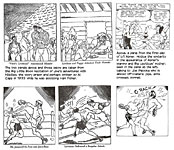
In the Fisher version of these events, Fisher had the idea for Big Leviticus and wrote the story, leaving the illustration of it to Capp. In other words, he followed his usual practice in producing the strip.
The Big Leviticus story ran on Sundays in November 1933. Capp quit working for Fisher soon thereafter. He’d been working up a comic strip idea at home in the evenings, and by late winter, he was taking samples around to syndicates. In an interview with Rick Marschall in Cartoonist Profiles no. 37 (March 1978), Capp related his selling adventure:
I brought the Abner samples up to King Features, and they offered me 250 bucks a week, which is the equivalent of a thousand—even more—today. But the big guy there—[Joe] Connolly—said, “Great strip, great art, yes sir. A couple of things, though. That Abner’s an idiot. Make him a nice kid with some saddle-stripe shoes on him. And Daisy Mae’s pretty, but how about some pretty clothes? As a matter of fact, why not forget the mountain bit and move them all to New Jersey; and that Mammy—she’s got to go. You need a sweet, white-haired lady.”
Well, I thought all about it, and I realized that [he was describing] Polly and Her Pals. But I had 250 bucks a week, didn’t I? Well, I was pretty sick about it. I walked up to United Feature—[Monte] Bourjaily was the head of it then—and they looked at it, showed it to Colin Miller and the other salesmen, were amazed by it and wanted to take it out just as it was. They offered me 50 bucks a week—which was the lowest—and I grabbed it and forgot King Features because I was now able to do my own strip exactly as I wanted to. Later on, of course, they paid me $5,000 a week because there was no way they could get out of it (14).
Capp was ever after unhappy with his relationship with United. He was continually fighting for more editorial freedom. In 1947, he sued the syndicate for $14 million, alleging breach of contract, but settled out of court for an undisclosed amount. And in 1964, just after he acquired ownership of the strip, he took Li’l Abner to another syndicate, the Chicago Tribune-Daily News, where he negotiated a better deal.
Marschall continues his recounting of the story of Li’l Abner’s sale, saying Capp had told the story thousands of times. “Capp’s late Uncle Harry related to me that the problem at King Features simply was that they took too long to respond. I’m sure the truth is in both recollections. Capp’s brother Elliott told me that Al’s straight biography and his embellished versions of it are equally fascinating” (14).
Capp, a professional storyteller, knew a good story when he heard one, and to such a storyteller as he, a good story was a great improvement upon whatever mundane facts might be lying around. He often laminated his autobiographical comments with variations that improved the story or supplied a satisfying punchline.
As a matter of documented history, in June 1934, Capp signed a contract with United Feature, and Li’l Abner started in eight newspapers on August 13 (by Christmas, according to some accounts, it was in 400 papers; eventually, 900-1,000). Abner’s debut was less than a year after the Big Leviticus episode in Joe Palooka. Judging from the sequence of events, Fisher assumed that Capp had found his inspiration for a comic strip about hillbillies in the Big Leviticus story.
Catherine Capp, who had joined her husband in New York once he was on Fisher’s payroll, wrote an introduction to Volume One of the Kitchen Sink Press Li’l Abner reprint series in which she remembers inspiration striking in another way:
One night while Al was working for Fisher, we went to a vaudeville theater in Columbus Circle. One of the performances was a hillbilly act. A group of four or five singers/musicians/comedians were playing fiddles and Jews harps and doing a little soft shoe up on stage. They stood in a very wooden way with expressionless deadpan faces and talked in monotones, with Southern accents. We thought they were just hilarious. We walked back to the apartment that evening, becoming more and more excited with the idea of a hillbilly comic strip. Something like it had always been in the back of Al’s mind, ever since he had thumbed his way through the Southern hills as a teenager, but that vaudeville act seemed to crystalize it for him. ...
Al and I conferred about the characters while he was drawing his samples. I’ll take credit for naming Daisy Mae and Pansy Yokum, although contrary to popular belief, I was not the model for Daisy. The closest I came to being a model in the strip happened later when Al used my hair for Moonbeam McSwine (4).
It wasn’t just her hair. Capp once said that Moonbeam was inspired by Catherine because she, disliking big city life, spent her time on the Capp farm, out in the country—among the cows and pigs, like Moonbeam who preferred livestock and hog wallow to social high life. (Or maybe Capp was merely improving upon a good story by giving it a fictional punchline.) Indirectly, Catherine also named the strip’s protagonist: “‘Abner,’” she wrote, “was what we had nicknamed the baby when I was pregnant; it’s what we called Julie before she was born.” For Abner’s appearance, Capp claimed to be inspired by Henry Fonda, an unlikely contention on the face of it: Fonda was scarcely a national figure at the time; his first movie was in 1935, at least months after Li’l Abner was launched. But it was Fonda’s character Dave Tollier in “The Trail of the Lonesome Pine” in 1936, Capp said, that gave him the “right look” for Abner.
Although it’s not clear from Catherine’s account whether the young couple witnessed the vaudeville act before or after the creation of the Big Leviticus episode, the hillbillies on stage undoubtedly excited Capp’s imagination, leading, eventually, to a strip featuring hillbillies as the central characters.
Li’l Abner Yokum is a red-blooded nineteen-year-old with the mature physique of a body-builder and the mind of an infant who lives contentedly with his diminutive mother, Pansy, the pipe-smoking matriarch of the family, and his simpleton Pappy in poverty-stricken Dogpatch, a backwoods community perched precariously on the side of Onnecessary Mountain (or, sometimes, languishing in its shadow). “Yokum,” supposedly a combination of “yokel” and “hokum,” was actually phonetic Hebrew, Capp once said—“joachim” means “God’s determination”; it was “a fortunate coincidence that the word would also pack a backwoods connotation” (Wikipedia).
The
only cloud in young Abner’s idyllic everyday blue sky is Daisy Mae Scragg, a
skimpily clad blonde mountain houri who is forever pursuing him with (“gulp”)
matrimony in mind; Li’l Abner, too stupid to realize even that he loves her,
shuns the nuptial bond as well as her embrace, imagining them as somehow
unmanly. Daisy Mae drags him before Marryin’ Sam at least once a year, but the
ceremony is invariably nullified by some groaning plot contrivance; when Capp
finally married them for good, he’d enjoyed eighteen years of dangling the
prospect before his readers. Li’l Abner’s shyness with women and his studied
reluctance to recognize sexuality at all is a satire on American puritanism:
if things were as puritans imagined, Abner wouldn’t be funny. But he is funny,
revealing that we all recognize at once how absurd the a-sexual repressiveness
is. 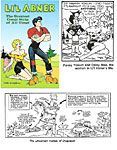
Capp’s Candide, Li’l Abner is fated to wander often into a threatening outside world, where he encounters civilization—politicians and plutocrats, mad scientists and cunning swindlers, mountebanks, bunglers, and love-starved maidens. By this device, Capp contrasts Li’l Abner’s country simplicity against society’s sophistication—or, more symbolically, his innocence against its decadence, his purity against its corruption. The comedy arises from this clash of cultures: we laugh to see Abner’s simple-minded struggle against the forces of civilization that seem to him so inexplicable, so utterly without practical foundation, and we roar with satisfaction when he eventually triumphs over the twisted insincerity of “high society,” his innocence, his ignorance, intact. Throughout, the humor is circumstantial, arising from the preposterousness of Abner’s predicament and his simplicity in dealing with it, rather than from carefully structured jokes. Capp’s effort was not so much to end his daily strips with punchlines as it was to finish with extravagant cliffhangers.
It was man and his society that comprised Capp’s primary targets. As a satirist, he ridiculed the pretensions and foibles of humanity—greed, bigotry, egotism, selfishness, vaulting ambition. All of man’s baser instincts, which the cartoonist saw manifest in many otherwise socially acceptable guises, were his targets. Li’l Abner is the perfect foil in this enterprise: naive and unpretentious (and, not to gloss the matter, just plain stupid), Li’l Abner believes in all the idealistic preachments of his fellowman—and is therefore the ideal victim for their practices (which invariably fall far short of their noble utterances). He is both champion and fall guy.
Capp’s vehicle was burlesque, a mode of satirical comment that allows no fine gray shadings—only stark blacks and whites. Painted only in these hues, the world he revealed was divided simply into the Good (the Yokums) and the Bad (almost everybody else). And Capp’s tactic was the shotgun: a single blast that obliterated his target without fuss or, usually, finesse.
His
criticism of American foreign aid, for instance, was contained in the creation
of Lower Slobbovia, a completely snowbound fifth-rate country whose
inhabitants, up to their chins in hostile environment, have no visible means of
support. Their favorite dish is “raw polar bear and vice versa.” Speaking in a
strange-sounding language fraught with not-so-faint echoes of Yiddish, the
natives survive entirely on the hope that the United States will provide
foreign aid. Beyond the joke of the Slobbovians’ helplessness and laziness and
their abject poverty and perpetual starvation, the satire goes nowhere. Having
taken his shot, Capp seemingly runs out of ammunition. The initial
conception—the Slobbovians and their impossible plight—is brilliant as a
criticism of American foreign policy; but Capp typically goes nowhere else with
the notion. His Slobbovian stories end but not with a sharply satirical barb
that turns on itself to sting. 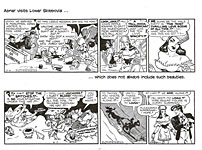
In his interview with Marschall, Capp admitted that he was “so embarrassed by his endings that I try to forget them” (14). Many of his endings are thoroughly forgettable, but sometimes, often enough, Capp excelled.
Abner’s first adventure is a happily contrived satire ending with sting enough. In the first sixteen months of his life, Li’l Abner, the quintessential country hick, spends more time in New York City than in the hills of his home in Dogpatch. And in that circumstance is the flywheel of the strip’s satirical dynamic.
At the very point of our meeting Li’l Abner and his hillbilly entourage, Abner gets a letter from his rich Aunt Bessie, who invites him to spend time with her in New York society in order to acquire polish and to enjoy “the advantages of wealth and luxury.” Abner goes to the big city and stays there for the next four months.
In one episode of that sojourn, a phony baron (actually, a penniless confidence man) with an impressive beard goes after Aunt Bessie’s hand in marriage, his eye firmly focused on her fortune. Li’l Abner finds out that the baron’s intentions are less than honorable, but he’s helpless to do anything about it. His first instinct is to “smack the baron aroun’ somewhat an’ throw him outa th’ house,” but he recognizes that this behavior isn’t gentlemanly, and since his Mammy has sent him to Aunt Bessie to learn to be a gentleman, he dutifully refrains from taking this course of action.
And when he decides simply to go to Aunt Bessie and tell her what a lout the baron is, he learns that his aunt is in love. Rather than destroy her happiness, he says nothing to her about the mercenary intentions of her lover and soon-to-be-husband. It seems that Bessie is doomed to be duped.
At
the last moment—just before the wedding—Abner remembers a smattering of his
Mammy’s wisdom: “Anyone which is a skunk looks like one.” Putting this axiom
into practice, he gets a razor and forcibly gives the phony baron a shave.
Without his imposing chin whiskers, the con-man is revealed as a nearly
chinless simp. Bessie is no longer impressed, and she calls off the wedding.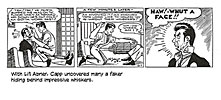
The story is an insightful template for Capp satire, a handy guide to his method. Again and again over the next decades, he would perform this operation—stripping the pretensions away, revealing society (all civilization perhaps) as mostly artificial, often shallow and self-serving, usually avaricious, and, ultimately, inhumane and therefore without meaning. We laughed, but underneath the strip’s comedy, it wasn’t funny.
In his book America’s Great Comic Strip Artists, Marschall found a determinedly misanthropic subtext in the satire of Li’l Abner:
Capp was calling society absurd, not just silly; human nature not simply miguided, but irredeemably and irreducibly corrupt. Unlike any other strip, and indeed unlike many other pieces of literature, Li’l Abner was more than a satire of the human condition. It was a commentary on human nature itself (246).
In the story of the shmoo, Capp created what was probably the most sustained satire in the strip: this sequence had a beginning and an end, and all along the way, it supported and reinforced the satire. The shmoo, for those who missed it, is a soft, squishy-looking bowling-pin of a cuddly critter with two legs and feet but no arms, two eyes and one mouth but no nose, whose whole purpose in life is to make others happy, which it does by magically producing all sorts of foodstuffs and other useful items. They lay eggs “at the slightest excuse” and give milk and cheesecake; as for meat—broiled they make the finest steaks; fried, yummy chicken. They drop dead out of sheer ecstasy if you look at them hungrily. And there’s no waste: their hide makes the finest leather or cloth (depending upon how thick you slice it), their eyes make suspender buttons, and their whiskers, toothpicks. Moreover, they are available in endless supply because they breed more rapidly than fruit flies.
Li’l Abner stumbles onto shmoos in August 1948 and the world is subsequently on the brink of changing forever: once shmoos are loose in so-called civilization, humanity loses the motivation to go to war and to engage in every sort of capitalistic enterprise. Why bother? Shmoos provide everything one needs. And for that very reason, in Capp’s satirically warped mind, they had to be destroyed wholesale. Otherwise, they would “corrupt” society, demolishing the very things upon which civilization is founded—namely, greed and need. The character was such a happy satirical conception, so cute, and so popular (and so successfully merchandised), that Capp brought it back briefly in 1959, but without the merchandising success of its inaugural appearance.
Because he attacked the conventions of modern civilized society and because the most conspicuous upholders of those values were the wealthy and powerful members of the establishment and because America’s establishment was mostly political conservatives, most of the icons Capp smashed so exultantly were those of the political Right. Consequently, Capp was extremely popular with liberals.
A protean talent, Capp invented a host of memorable characters and introduced a number of cultural epiphenomena. His cast is populated with Dickensian eccentrics: the denizens of Dogpatch—Lonesome Polecat, the local Native American, and his partner in brewing Kickapoo Joy Juice, a hirsute giant named Hairless Joe; Earthquake McGoon, the neighborhood strongman; Barney Barnsmell, the “outside man” at the Skonk Works (the only indigenous industry), and his brother, Big Barnsmell, the “inside man”; the Wolf Gal, a rapacious wild girl; Senator Jack S. Phogbound; the voluptuous Moonbeam McSwine, who likes pigs better than people; and in the world beyond Dogpatch—Joe Btfsplk, a jinx whose influence was symbolized by the small raincloud that hovered always over his head; Evil-eye Fleegle, whose glance could fell an ox; Lena the Hyena, a woman so ugly Capp wouldn’t draw her; and Appassionata van Climax, an outrageously flagrant sex symbol (about which, Capp reported in surprise, no editor ever objected). Perhaps the most famous of his secondary characters is the one that threatened at times to take over the strip: introduced in August 1942, Fearless Fosdick is a razor-jawed parody of another comic strip character, Dick Tracy.
The most notorious of Capp’s contributions to popular culture is Sadie Hawkins Day, an annual November footrace (the precise date of which varies from source to source—and, doubtless, from year to year in Capp’s own mind) in which the unmarried women of Dogpatch pursue unmarried men across the countryside like so many hounds after the hare, marrying those whom they catch.
WHEN FISHER LATER CLAIMED that he created the first hillbillies on the funnies page, strenuously suggesting that his one-time assistant had stolen the idea from him, Capp, at first, treated Fisher’s claim with disdain. “I tried to ignore him,” he said in Newsweek (November 29, 1948). “I regard him like a leper; I feel sorry for him, but I shun him” (clipping, n.p.). That only enraged Fisher. He was determined to make his case. By 1954, in his autobiographical essay, Fisher had even invented a trip through the South that paralleled Capp’s legendary youthful trek. Wrote Fisher:
One great adventure in meeting people was on a selling trip at the age of eighteen when I spent several months among the hillbillies through the Great Smokey region of the South. Later, when I took Joe Palooka on a barnstorming tour, they came in mighty handy as the first hillbillies to appear in the comics. I dropped the hillbillies after several months, but they had made a hit, for many hillbilly comic strips sprung up the following year. Big
Leviticus, whom I originally called Li’l David, was a wild paranoiac character, and my great and good friend, the late John Custis, one of my publishers, tagged him as an unsavory specimen. His objection was that Leviticus was no fit company for a nice guy like Joe. You see, Leviticus had a bad habit of trying to kick Joe in the jaw while boxing (6).
The rhetoric of this contrivance is notable for its transparent argumentative ingenuity. Although seemingly a casual narrative of a mildly interesting incident in Fisher’s life, it is laced with attacks and defenses. He repeats his claim of being the originator of hillbillies in comics, and he adds that Leviticus was originally called Li’l David; from whence, clearly, Capp derived the “Li’l” of his Abner. Leviticus is an unsavory specimen; hence, so is Li’l Abner. John Custis, who could have verified this story, was conveniently dead.
That Fisher’s obsession about Capp had become utterly shameless can be deduced from the venue of the essay—an instruction booklet for a correspondence course in illustration and cartooning. Coulton Waugh, the author of the course in which Fisher’s essay is a part, asked Fisher to tell how he became successful rather than to supply a drawing lesson: Waugh’s expectation was that Fisher’s story would be inspirational to aspiring young illustrators and cartoonists. The hillbilly origin tale is wholly extraneous to the essay’s ostensible purpose—and to its running argument. But it is integral to what had, by this time, become Fisher’s absorbing preoccupation: that the hillbillies who were making Capp rich and famous appeared first in Joe Palooka.
And Fisher was right. In Al Capp Remembered, published in 1994, 15 years after Capp’s death, his brother Elliott wrote: “Alfred never quibbled about the obvious relationship between Big Leviticus and Li’l Abner. He freely admitted that his hillbilly was germinated in the Sunday pages of Joe Palooka” (72).
The essential fact was never in dispute. At issue was who created Big Leviticus. If Capp created Big Leviticus, he could scarcely be accused of “stealing” the hillbilly idea; he could, therefore, readily admit to the connection between Big Leviticus and Li’l Abner.
We’ll probably never know, with certainty, the truth about who created the hillbillies in Joe Palooka. But it is more than probable that each of the participants in the dispute has a piece of the truth on his side. Take the question of the “creation” of a comic strip character. In his mind, Fisher could legitimately claim to have created Big Leviticus and his obnoxious family even if all he actually did was to give Capp instructions to do a sequence about Joe Palooka fighting a roughneck hillbilly. The concept, as they might say these days in Hollywood and other suburbs in Lala Land, was Fisher’s. The execution might have been left entirely to Capp. And if Capp fleshed out the idea—gave personality to Big Leviticus and his entourage—he could legitimately claim to have “created” the character, too.
Weiss is certain that Fisher’s version of this episode is the truth. “I don’t know how it could be documented,” he told me. “I can only go by knowing Ham Fisher’s character—knowing what he was like—what he would do and what would be foreign to him. As far as the Leviticus thing is concerned, it would have been foreign to him to have let someone take over the strip at that time; it just wouldn’t have been done. And also, Ham Fisher showed me a letter once. And I don’t know what happened to it. But it was a letter that, during the feud, Al Capp wrote to [George] Carlin, the head of United Feature Syndicate, in which he said, he admitted, that Ham created Leviticus, and he’d like to put the matter to rest, and he would admit that it was not his character, that it was Ham’s. Well, what happened then was Ham got that letter and took it around to nightclubs and showed it to different people, and when Capp got wind of it, the feud was on all over again, hotter than ever.”
In their new biography, Al Capp: A Life to the Contrary, Michael Schumacher and Denis Kitchen allude to this mysterious note, but they didn’t find it either. Despite unprecedented access to Capp’s papers and the cooperation of his children and grandchildren, they are unable to be any more definitive than Weiss. No surprise: not everything in such a long and energetic life as Capp’s can be documented in writing (although the biographers found love letters to document Capp’s long affair with a singer in southern California.)
In their Big Leviticus scenario, Schumacher and Kitchen manage to favor both sides of the debate by knitting a few known facts together with a few reasonable speculations and adding some probably fictional connective tissue to create a cohesive story. They suppose that Capp brought the idea of hillbillies to story conferences with Fisher, but Fisher wrote the script for the Big Leviticus adventure. In support of this contention, the biographers cite a long-standing custom in the syndicate business that cartoonists submit scripts to their syndicates for approval before drawing the strips. In their narrative, Fisher did not go on vacation: he was present while Capp drew the sequence. Big Leviticus shows up again in the strip a few months later while Capp was still there, and it was during this time, they say, that Fisher went on vacation. In short, Schumacher and Kitchen find it highly unlikely that Fisher’s “brand new assistant” soloed on the Big Leviticus story so soon after joining Fisher (62-68).
This interpretation of events is as plausible as any other, and in its resolution, it agrees with Weiss’s supposition based upon his long acquaintance with Fisher. But the explanation is scarcely leak-proof. Not all syndicated comic strip cartoonists were required by their syndicates to submit scripts for advance approval. And by 1933, Fisher’s strip was roaringly successful; it’s at least probable that he wouldn’t have been expected to get approval in advance for his stories. Moreover, in support of Capp’s version of events, Big Leviticus’ behavior is more akin to the sort of comedy Capp would later develop in Li’l Abner than anything Fisher had done or would do. Still, Weiss’s conclusion remains the most convincing version of this famous episode in Capp’s life.
Fisher’s persistence in claiming to have created the first hillbillies in the comics had about it exactly the whining quality that doubtless rubbed Capp the wrong way, stimulating his rambunctious satiric sensibility and prompting him to do whatever he could to irritate Fisher. And as we shall see, he found opportunities to do just that.
But whether Capp was inspired by the vaudeville act, by his own experiences on a trip into the South years before as a youth, or by Fisher’s Big Leviticus is probably beside the point. Regardless of how hillbillies found their way into the comics, their arrival scarcely represented an isolated act of divine afflatus.
As Dave Schreiner points out in Volume One of the Kitchen Sink series, hillbillies were “in the air” in those days. Hillbillies were on stage and in songs (11). And in books and movies. And on the radio. In the introduction to Volume 26 of the Kitchen Sink reprints, M. Thomas Inge writes: “It is no exaggeration to say that culture in the United States, high and low, had been obsessed with things Southern and Appalachian since the turn of the century” (6). Between 1908 and 1928, Hollywood produced over 475 films about the backwoods South. “That is an average of over twenty-two films a year, almost two a month,” Inge notes (13). And with the advent of radio as the preeminent entertainment in American homes in the 1920s, such programs as “The National Barn Dance” from Chicago and “The Grand Ole Opry” from Nashville were heard everywhere. Hillbilly string bands, banjo players, fiddlers, gospel singers, and comedy groups traveled across the country, appearing on stages in most cities. It was one of these that the Capps saw in New York in 1933.
The emergence of hillbillies in popular culture in the thirties may have been a consequence of the disruption of rural life during the Depression. Many country dwellers—hillbillies as well as dirt farmers everywhere—left the country for the city, where they hoped to find a livelihood. Their advent raised the consciousness of big city residents about these colorful characters, and because they were colorful, they were ripe subjects for comic strips. In 1934, cartoonist Billy DeBeck, responding undoubtedly to the currents of interest he detected in popular culture at the time, took his horse-racing hero, Barney Google, into the hills where he met a scruffy distiller of illegal brew named Snuffy Smith, who eventually took the strip away from Google. Fisher never accused DeBeck of stealing hillbillies from him. But DeBeck had never been Fisher’s assistant.
But all that, as I said, is beside the point. Whatever the actualities of the matter, Fisher was aggrieved. And his grievance would fester for years until it erupted in the profession’s most notorious scandal.
Chapter Five
BY THE END OF THE THIRTIES, Fisher’s strip was secure among the top five strips in the country. Then he did an unprecedented thing. He enlisted his hero and his strip in the cause of democracy on the eve of the Second World War. It was not only unprecedented: in many corners of the country, it was unpopular.
Isolationists, wary of European intrigues because of the unsatisfactory resolution of World War I, vociferously resisted any inclination President Franklin Delano Roosevelt might occasionally voice about support for Britain, which, by the summer of 1940, was the only European nation not under the tread of Adolf Hitler’s war machine. By way of preparing for emergencies, however, FDR had succeeded in launching universal military conscription late that summer. And Fisher helped FDR put over the idea of the draft by having Joe Palooka enlist. Joe went in as a private even though he was offered a commission. (Another heavyweight champ, Joe Louis, would soon do exactly the same; and by so doing, Louis increased the respect and regard in which he was held by his fellow Americans.)
Fisher carefully researched Army camp life and depicted it with meticulous attention to detail. And Joe became the voice of patriotism—not strident and shrill or loud and bombastic but soft-spoken and sure, confident. T. Wayne Waters, writing in American History magazine (December 2002), reports that Undersecretary of War Robert Patterson gave Fisher a letter of introduction that allowed the cartoonist to tour army training camps to gather information that would enhance the strip’s authenticity. Joe’s enlistment and his subsequent conduct helped convince young Americans to put on uniforms in the year before the U.S. was officially in the War. Roosevelt was grateful and said so, inviting the cartoonist to lunch at the White House. And so, as Martin Sheridan records in Comics and Their Creators, Ham Fisher had become the Friend of Presidents (132-33).
In the strip, Fisher courageously advocated more than ordinary patriotism. He was an outspoken proponent of racial tolerance, too, in an age when even the military services were segregated. Said Joe: “Anybuddy back home who’s spreadin’ intolerance against any person b’cuz of his race, creed or color is spreadin’ Nazi principles.” Oddly, as boxing champion while still a civilian, Joe has a black valet named Smokey, who is drawn as a liver-lipped racist caricature. Over the years, Smokey undergoes a transformation, losing some of the stereotypical shuffling subservient characteristics and becoming Joe’s sparring partner and companion when the two join the Foreign Legion. But visually, he was still a nasty caricature; he disappears from the strip in the early 1940s, and we never see him again.
Joe had many combat adventures throughout the War. Starting right after Pearl Harbor, Palooka captures a German submarine while en route to Europe, then foils the attempts of parachuting saboteurs, invades Europe with a unit of commandoes, blows up a German gasoline plant thereby enabling an observation plane to escape enemy artillery, steals a radio and sets up an underground radio station to guide Allied bombing missions, and participates in two exhibition boxing matches. All that during the first nine months of his enlistment. Our hero is captured and escapes but is reported missing in action; his friends and comrades are wounded but survive. Joe was wounded, too, parachuting into partisan Yugoslavia where he joined a guerrilla force (led by a beautiful patriot, who nurses Joe back to health; Joe, of course, resists the woman’s romantic blandishments because for him there is only one woman, Ann Howe).
During
an adventure in North Africa, Joe is shown shooting an escaping Nazi prisoner
in the back. It was a simple default option in depicting the action: the guy is
running away, right? But many readers were upset seeing this morally
questionable act committed by a champion of clean-cut American fair play, and
they wrote newspapers expressing dismay. Joe never fouled an opponent in the
ring; why now? Joe Palooka was so popular that the incident was reported
in Time. The magazine even offered an explanation: “Joe, like any other
U.S. soldier, is up against unsporting enemies, and he must learn to kill or be
killed. Says Palooka’s creator, jovial cartoonist Ham Fisher: ‘No good soldier
is going to be polite in real war. Why should Joe?’”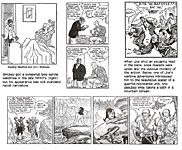
With similar dedication to authenticity, Fisher managed to conduct his comic strip version of the battle of Tunisia concurrently with the real campaign. Both finished at about the same time. Knowing that supply was vital to British Field Marshall Bernard Montgomery’s movement, Fisher timed the progress of his fictional battle by watching the movement of supplies to North Africa, information he obtained through an obliging British liaison officer. Fisher was so favored by the British because he had been a vocal interventionist during the dark days early in the European conflict when England most needed U.S. help.
Joe Palooka was among the few civilian productions published in Stars and Strips, and Palooka appeared also in training manuals, recruitment materials, guides to invaded countries, and hygiene and safety booklets. Back home, Knobby found work in a defense plant, and Ann became a Red Cross worker. Once, when the Army needed candidates for Officer Candidate School, Fisher considered sending Joe to OCS but decided against it after he got a letter from Major General A.D. Surles, War Department Public Relations Chief, who argued that a greater morale purpose would be served if Joe remained an enlisted man. When the War is over and Joe returns to the U.S., Fisher did a special comic book that shows his hero confronting the psychological problems of readjusting to civilian life.
The strip was a decided morale-booster among those in uniform. Fisher had given his creation a social purpose beyond entertainment, and he had also enhanced its already considerable popularity.
During the War, many comic strip heroes went into military service to help build morale. But Li’l Abner didn’t. At least, not in the civilian press. Capp no doubt felt his loutish protagonist was too quintessentially hillbilly for his readers to believe that he could serve in the military. He was no Sergeant York. Besides, as Caniff pointed out in his postwar contribution to the book While You Were Gone, a collection of essays aimed at reacquainting vets with the home front, “the mail from the foxholes, I am told, added up to a spontaneous Gallup poll of the inducted ten million. In one voice, homesick American youth begged Capp to keep Dogpatch and the Yokum clan intact, beyond the reach of the draft board” (502).
It may have been Capp himself who most forcefully enunciated this sentiment. In a letter addressed to the reader in Li’l Abner for July 4, 1942, Capp explained why Li’l Abner would not be going into the army:
Perhaps Li’l Abner and his friends, living through these terrible days in a peaceful, happy, free world will do their part by reminding us that this is what we are fighting for—to have that world again. ... a world where a fella is free to be as wise or foolish as he pleases—but mainly—a world where a fella is free! That world has disappeared—until we win this war. Perhaps this small section of our daily newspaper can do its part best by helping us to remember that a free world once did exist—and will again!
It was by far a more patriotic reason than Abner’s abject unmilitary stupidity. But Capp did a special Pfc. Li’l Abner strip for military training manuals and contributed pictures of his hero to other causes within the ranks. And that wasn’t all.
Capp may have been “smarting at the public attentions showered upon his hated onetime employer Ham Fisher” for volunteering Joe Palooka a couple years before, Jay Maeder speculates in Hogan’s Alley no.12 (2004), so he “offered his professional services as a highly visible home front propagandist” for the Treasury Department’s war bond sales program (106). And for domestic consumption, starting in 1942, Capp produced an unsigned (but obviously in the stylistic manner of Li’l Abner) biweekly Sunday strip called Small Fry (later changed to Small Change). Intended to promote the sale of war bonds, the feature retailed the adventures of its bulb-nosed eponymous protagonist as he concocted schemes to raise the money to buy a bond in order to win the favors of his luscious leggy girlfriend, Tallulah, a dark-haired, Bettie Page-bangs version of Daisy Mae (albeit in skimpy cutoffs rather than a tattered skirt).
Said Tallulah: “So what ef all th’ Yew-nited States armed services has rejected yo’, Small Fry. Yo’ kin still fight by buyin’ U.S. war bonds. They is $18.75 an’ up, an’ fo’ each one yo’ buys, Ah will bend yo’ nose back an’ give yo’ a big, juicy kiss.”
Who
could resist? One look at the bangs and the cutoffs would be inducement enough.
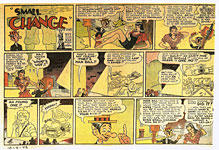
Capp also performed a special personal mission: in military hospitals, he visited amputees. The theme of his conversations, Caniff reported later (in my biography, Meanwhile), was always the same: “What will the girls think? Al invariably underscored the answer: it will make you twice as interesting” (428).
Cartoonists generally did their bit. In the New York vicinity, cartoonists frequently banded together to entertain recuperating soldiers in military hospitals. After the War, the cartoonists decided to perpetuate the fellowship they had all enjoyed while doing chalktalks for the troops: they formed the National Cartoonists Society. (For that story, see my “Tales of the Founding of the National Cartoonists Society” in Cartoonist Profiles nos.109, pp. 46-53, and 110, pp. 62-71; or in the NCS Album for 2005.)
Among the key players in the formation of NCS was Rube Goldberg. At the time, he was the Grand Old Man of cartooning. He had stature, the kind that inspired reverence not jealousy. Although he hated the formalities and rituals of organizational enterprises, he was persuaded to espouse the cause, and he became the first president of the Society. Fisher was among the first to join the group. And his behavior among his peers was telling.
NCS met most often at the clubhouse of the Society of Illustrators on East 63rd Street. The meetings tended to be short: the purposes of the group were, at the time, chiefly social, and those purposes were achieved in the clubhouse bar after the official meetings were adjourned.
In the bar, Weiss told me, Fisher kept himself nearly as busy as the bartender. All evening, he ran back and forth between the bar and the various tables at which cartoonists sat in groups, talking and laughing. Fisher took their orders and brought the drinks to the tables. Why would Fisher, one of the world’s most successful cartoonists, spend his evenings among his peers running drinks to them?
Fisher certainly regarded himself as a celebrity. His strip was one of the most widely circulated strips in the world. He referred to Joe Palooka as “the world’s greatest comic strip.” Despite all this—despite his undeniable success and fame—Ham Fisher was essentially an insecure individual. He bolstered his sense of worth by making himself necessary to the famous cartoonists in the room.
Weiss discovered Fisher’s insecurity very early. One evening at the clubhouse bar watching Fisher run drinks, Weiss decided to play a trick on him: “I stopped him and said, ‘Ham, when you have a minute, there’s something you should know about what an editor said about your comic strip.’ And he said, ‘What is it?’ And he dropped everything. And I said, ‘Well, I’ll tell you later; right now, I’m talking to someone else.’ I did it just to annoy him and irk him. Well, every five minutes, he was at me again to tell him what the editor said. But it was nothing; I made up the story. Just for the hell of it. Because I had him tagged.”
The incident revealed how vulnerable Fisher was, Weiss told me. And thereafter, he no longer felt like playing pranks on the man. “We seemed to have a sort of rapport after that,” Weiss said. “I would see him at the Society’s monthly dinners, and he would tell me stories. And then he would come over and visit me at our apartment in New Jersey.” Although Weiss never regarded himself as a particular friend of Fisher’s, he realized later that he had become Fisher’s confidante.
Fisher’s actions speak volumes about how unsure of himself he was. He sought the company of famous people. He went to great lengths to associate himself with them. He
courted celebrities by depicting them in the strip. He recognized consciously that he, too, was a famous person. But unconsciously, he wasn’t sure. He had to be convinced. To shore up his own opinion of himself he needed the reassurance he could feel if he were in the company of the people he regarded as famous. If he associated with famous people, surely he too was famous. His vanity—not to mention the very vitality of his self-esteem—was fed by his proximity to the famous.
And Fisher was unquestionably vain. He tooted his own horn. He carried around lists of all the newspapers that subscribed to his strip and would proudly produce them at the slightest provocation. Few major figures in cartooning ever make an exhibition of themselves like Ham Fisher did—proclaiming his own greatness to his peers, who all knew, as no other assembly of persons could, just how great he was.
They didn’t need Fisher to tell them about Fisher. They knew and appreciated his achievement. But they were turned off by his loud and boorish displays of self-adulation. And they saw through his obsequious servitude in the bar of the Illustrators clubhouse: they knew he was courting the favor of those whom he regarded as great. The rest of the company—the cartoonists whom Fisher did not see as very famous—Fisher ignored. And those cartoonists resented it. Resenting it, they were receptive to tales that revealed Fisher as they saw him. The story of Fisher’s treatment of Rube Goldberg, for instance.
At one of the early meetings of the Society, Weiss said, Fisher button-holed Goldberg, telling him how much he, Fisher, admired his work, how great Goldberg was, and so on. Later, Fisher confided to another cartoonist that it was “too bad” about Goldberg: the man was a has-been, he opined, over the hill. Goldberg heard about this. And it galled him. And it irked others who learned of it. The episode confirmed them in their low opinion of Fisher. Fisher, they could see, was a self-serving blow-hard, willing to advance himself at everyone else’s expense whenever the opportunity presented itself.
The situation was ripe for an incident to consolidate the feeling against Fisher. And Fisher, poor soul—vain, attention-starved, insecure and envious Fisher—precipitated the incident.
On the Sunday Joe Palooka page for October 31, 1948, Ham Fisher scratched an itch. In the opening panel, he lettered his message for the world to see: “First hillbillies ever to appear in a comic strip were Big Leviticus and his family [in Joe Palooka]. Any resemblance to our original hillbillies is certainly NOT coincidental.”
This was not the first time Fisher had made his accusation in public, veiled though it was. When he was interviewed by Martin Sheridan for Comics and Their Creators (published in 1944), Fisher said that other comic strips had adopted the prize fighter theme since he introduced it, and “many comics are based on hillbillies since I first used Big Leviticus in my strip” (132). Fisher had proffered similar assertions in his strip over the years. And among his colleagues in NCS, Fisher made no secret of his conviction that Capp had stolen from him the idea of hillbilly characters while assisting on Palooka in 1933. But in the fall of 1948, Fisher’s innuendo had the cutting edge of an indictment.
What prompted the October 1948 assault? Probably envy. Simple if not pure. Fisher had watched Capp’s climb to fame jealously. By the fifth year of Li’l Abner, Capp’s strip rivaled Joe Palooka in fame and popularity. And in the spring of 1948, Capp had won the Billy DeBeck Award, the NCS trophy for Best Cartoonist of the Year (now called the Reuben). It was only the second year of the Award, and it carried great status. (Milton Caniff had won the first year.) Despite Joe Palooka’s high standing in many readership popularity polls, Fisher would never be so honored by his peers. And with his insecurity, Fisher undoubtedly knew it, felt it in his bones: he would never win the DeBeck Award. With that realization gnawing at him, it must have rankled that his former assistant should win it. In any event, Fisher’s claim was just another refrain in the same old chorus as far as his brethren in the inky-fingered fraternity were concerned. What caused the outburst in the fall of 1948 is less significant than what Fisher’s action provoked. This time, Capp reacted.
Until then, Capp had behaved towards Fisher in the usual gentlemanly manner adopted by those of the profession. In public, he had only nice things to say about Fisher. In Sheridan’s book, for instance, Capp recounted the story of Fisher’s rescuing him from his poverty-stricken safari through the streets of New York. “I worked with Fisher for several months,” Capp said, “and owe most of my success to him for I learned many tricks of the trade while working alongside him” (136). Even then, Capp may not have believed what he said, but he knew that’s what ought to be said under the circumstances, so he played the game, sowing credit for another professional. Fisher, as we’ve noted, couldn’t play that game: he was too insecure to allow the spotlight on him to waver in its focus. And in the fall of 1948, Capp decided he would no longer play.
Capp announced that he was going to file a complaint with NCS. Maybe he hadn’t complained before because there had been no National Cartoonists Society to referee. Writing to the NCS Board of Governors and reported in Newsweek (November 29, 1948), Capp urged the group to call Fisher on the carpet for “reflecting discredit upon the Society. ... For a cartoonist to use his space to libel and slander another cartoonist is unethical, very bad for the profession” (58). But nothing came of Capp’s complaint.
Later, Capp decided to twit Fisher in public. Learning that Fisher would undergo plastic surgery to have his nose remodeled, Capp celebrated the event by introducing into his strip a horse named Ham’s Nose-bob. Still later, as their feud developed, Capp produced a Sunday sequence in which Li’l Abner draws a successful comic strip for a cheap scoundrel named Happy Vermin, who keeps Abner locked in a dimly lit closet while taking all the credit for the strip’s success himself, a success due entirely to Abner’s having discarded Vermin’s boring cast and replaced it with hillbilly characters.
Says Happy Vermin: “I’m proud of having created these hillbilly characters! They’ll make millions for me!! And if they do, I’ll get you a new light bulb!”
Retaliating to Capp’s frontal assaults, Fisher stepped up his campaign. He spread salacious gossip about Capp, and in whatever company he found himself, he proclaimed the Fisher gospel (that he, Fisher, had invented comic strip hillbillies that Capp then stole from him). Visiting Weiss at his apartment, he often carried on a tirade. Said Weiss: “He went on about how Al Capp had stolen his characters, and how he was defaming him. And he raved about Capp’s being a sex maniac and the vulgar things he was putting into his comic strip, and he went on and on and on. I remember so many things about that. It consumed him completely. One time he said, ‘Great things are happening to me now. The detective that Al Capp had following me to get dirt on me, that detective is now working for me, that private detective.’”
Interlude
LONG BEFORE PRODUCING the comic strips Miss Peach and Momma, cartoonist Mell Lazarus was an editor at Toby Press, the publishing entity set up by Al Capp to publish Li’l Abner comic books and the ancillary products of Al Capp Enterprises. Toby Press was run, more-or-less, by Al’s brothers Jerome (“Bence”) and Elliott. In September 2012, I interviewed Lazarus on an array of comics-related topics, and during our conversation, he told me about an encounter he had while the Capp-Fisher feud was transpiring. Lazarus and his then-wife used to finish up the week by having a drink together in a bar on Fifth Avenue. And for a couple of weeks, they noticed a man at a nearby table who seemed to be eavesdropping on their conversation. Finally, one Friday, the man got up and came over to their table.
“Pardon me,” he said, “but I couldn’t help overhearing you mention Al Capp.”
“Yes?” said Mell.
“Do you know Al Capp?” asked the man. “Do you see him often?”
“Yes”
“Well,” said the stranger, “my name is Ham Fisher, and I wonder if you’d give him a message from me. Tell him I’d like to be friends again. Tell him he’s won. All I want is that we should be friends again.”
The next time he saw Al Capp, Lazarus reported the incident—“to Al’s giddy delight. He seemed pleased,” Mell told me, “and amused. But he didn’t dwell on it with me, nor did we ever discuss it again.”
FISHER’S QUARREL WITH HIS ONE-TIME ASSISTANT continued and became an obsession, and that, coupled to his own oft-trumpeted self-importance, made Fisher a colossal boor. It also made him the perfect target for any number of practical jokes staged by other cartoonists, most of whom by this time had little regard for him.
Once, as reported by Bob Dunn in Cartoonist Profiles no. 40 (December 1978), when Fisher threatened to derail a charity luncheon at “21” from its purpose by usurping the agenda to attack Capp, one of the group slipped out and recruited a comely young woman to deliver Fisher’s comeuppance.
Unannounced, she walked into the third floor private room and made straight for Fisher. She was good-looking enough to stop conversation: everyone watched her progress in silence. Giving Fisher a brilliant smile, she handed him a piece of blank paper and asked for his autograph. Dazzled by her beauty and flattered by the obvious adoration of such a gorgeous creature and gratified by thoughts of the envy her admiration must inspire in those around him, Fisher drew the face of his famous character and signed it “with all good wishes from Joe Palooka and Ham Fisher.”
The girl took the paper and stared at it in frowning perplexity. Then, tearing the paper twice and dropping the pieces on the floor, she exclaimed, “You’re not Al Capp? I wanted Al Capp’s autograph!” She turned on her heels and strode away.
The room exploded. Fisher turned white in rage and embarrassment. No man can take a joke about his obsession (35).
Knowing Fisher employed assistants to draw Joe Palooka, cartoonists circulated the rumor that Fisher couldn’t draw at all. Ironically, Capp’s practice in producing Li’l Abner was very similar to Fisher’s with Palooka.
Capp had help drawing the strip from the start. His wife Catherine did the backgrounds—landscapes and trees—and some inking. Capp soon acquired Moe Leff for a time, and then Andy Amato; then Walter Johnson, and Harvey Curtis. Amato was with Capp the longest—from near the beginning until the end. Amato penciled the strip—or, perhaps in the early years, tightened Capp’s pencils for as long as Capp roughed out the panels; Johnson did a lot of the inking, and Curtis did the lettering and filled in the blacks. Like Fisher, Capp drew the faces of his principals, but no one spread about Capp the rumor that he couldn’t draw.
Other assistants came and went over the years, coming from or going to a fame of their own—Bob Lubbers for the longest (reportedly 1958-1977); Frank Frazetta on Sundays (1953-1961); and for shorter periods, Stan Drake, Creig Flessel, Tex Blaisdell, Larry May. And others. But Amato, Johnson and Curtis also helped write the strip. Capp concocted plots in conference with them.
Describing what he called “the ensemble effort” of writing the strip in Al Capp Remembered, Elliott Caplin said: “The story sessions were often romps through the wildest fantasies of the four men. Each bought to the studio his own prodigal dreams and tried to flesh
out his urges, prejudices and hang-ups in an Abner continuity. ‘How about’ was the kick-off for a story conference. ‘How about this guy who’s never been to a city bigger than like a couple of hundred people ... and looking for a girl whose picture he’s seen on the cover of—no, maybe not a magazine, but a poster. ...’
“The four men would explore and dissect the story line,” Elliott continued. “A hundred variations were discussed and discarded. Time would pass, and eventually a continuity was fashioned that could be a hundred years away from the initial concept. Alfred appreciated and rewarded his staff. He especially valued Andy Amato for his unorthodox and undisciplined flights into absolute insanity. Andy felt free to soar, knowing that Alfred would exercise his superb story sense in fashioning the final drawn version of Andy’s frequent bouts with paranoia” (81-82).
In a 1950 cover story on Capp (November 6), Time reported that Amato and Johnson were paid 10% of Capp’s profits, about $30,000 a year apiece (78). A few years before, E.J. Kahn, Jr. in his profile of Capp in The New Yorker (December 6, 1947) claimed the assistants’ percentage was 15% and that it amounted to “around $35,000 a year between them,” high pay but Capp said it made his life easier: “I don’t like to have to spend a lot of time in the company of people who can’t sympathize with me when I complain about my income taxes,” he said (57). Although in these later years, the assistants were named in articles about Li’l Abner, I have only once encountered Capp speaking highly of them without at the same time lacing his comments with humorous jibes or satirical asides.
Rick Marschall’s interview with Capp in Cartoonist Profiles no. 37 was conducted shortly after the cartoonist’s retirement from the strip in 1977, and Capp said about his assistants: “When I say ‘I,’ I mean these other guys equally with me. I’m the guy who signed the strip, and I made up our minds about what we would do, but they had just as much effect on the strip as I” (14). Generous applause but a little late in coming compared to Fisher’s effusive published comments about his assistants as early as 1948.
In 1950, the Fisher-Capp feud boiled over. In the April issue of Atlantic Monthly was an article by Al Capp, purporting to explain the inspiration for the more villainous characters in Li’l Abner—“those unsanitary, uncouth, unregenerate, unspeakable apes, fiends, and human horrors whose lechery, treachery, and skulduggery make the golden goodness of the Yokums shine even more brightly by contrast.” Capp called it “I Remember Monster,” and although he never mentioned Ham Fisher by name, it was clear to anyone familiar with his well-publicized professional history that the monster was Fisher, his one-time employer. With his customary high-flying hyperbole, Capp claimed he didn’t have to invent any of those unsavory varmints that so invigorated his strip:
The truth is I don’t think ’em up. I was lucky enough to know them—all of them—and what was even luckier, all in the person of one man. One veritable gold mine of human swinishness. It was my privilege, as a boy, to be associated with a certain treasure-trove of lousiness, who, in the normal course of each day of his life, managed to be, in dazzling succession, every conceivable kind of heel. It was an advantage few young cartoonists
have enjoyed—or could survive. I owe all my success to him. From my study of this one li’l man, I have been able to create an entire gallery of horrors. For instance, when I must create a character who is the ultimate in cheapness, I don’t, like less fortunate cartoonists, have to rack my brain wondering what real bottom-of-the-barrel cheapness is like. I saw the classic of ’em all. Better than that, I was the victim of it (54).
Capp went on
for the rest of his four-page essay to retail extremely unflattering anecdotes
about the man he referred to only as his “Benefactor.”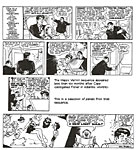
Goaded on, doubtless, by such humiliations and by his continued failure to get anyone to take him seriously on either hillbillies or Capp’s theft of them, Fisher resorted to a peculiarly unsavory way of striking back at his nemesis. In its 1950 cover story on Capp, Time said that Fisher had certain panels of Li’l Abner enlarged and reprinted, then, circling selected graphic details in red, he distributed them to the editors of newspapers carrying the strip. Alleging that the highlighted details were subliminal pornography designed to undermine the youth of the nation, he urged editors to drop Capp’s strip (77).
Capp’s article in the Atlantic Monthly and Fisher’s smear campaign brought matters to a head. The feud had become too public. It was unseemly and disgraceful that the creators of two of the most popular comic strips in the country should be so viciously tearing away at each other. Their respective syndicates, fearing they’d lose papers as a result of the fight, called for a truce, and a peace treaty was negotiated by proxies in August 1950. Unhappily, the story did not end then.
Chapter Six
A FEW MONTHS LATER, blow-ups of Li’l Abner panels taken from their reprinted version in comic books, were submitted anonymously to the New York State Joint Legislative Committee for the Study of the Publication of Comics, a body charged with determining whether or not comics should be censored. The Committee’s subsequent report included the Abner artwork. In several panels, the prominent nose of one citizen of Dogpatch had been extended to approximate the shape of a penis, and when he encounters a pretty girl, his nose stiffens. In one panel, another Dogpatcher and a female character are shown in a position approximating copulation. Written in the margin of this drawing was this proclamation: “This insane, perverted pornography is from Li’l Abner, yes!!! This is what Al Capp has perpetrated for 15 years on unsuspecting editors of American newspapers!!!”
This was the incident that would seal poor Fisher’s fate.
It was assumed immediately that Fisher had given the pictures to the Joint Committee: they were, after all, of the same ilk as those he had been circulating to newspaper editors. A good deal of lore has accumulated about this episode in the history of the profession. The biggest pile
of it is heaped up around the “doctored” drawings. It was claimed that they could not have been Capp’s work. Indeed, Fisher’s evidence itself seems to render his argument outlandish. The drawings are so blatantly suggestive as to trumpet their sexual double entendre: none of them, it must be supposed, could have slipped by an “unsuspecting” editor into print. Clearly, the drawings in possession of the Joint Committee were not Capp’s. Clearly, the panels from the
initial newspaper appearance of Li’l Abner had been tampered with on their way to their comic book reincarnation in evidence before the Joint Committee. Or so it would seem to any reasonable observer.
But whether the drawings were Capp’s or not, placing them before the Joint Committee created a crisis. Given the temper of the times (the McCarthy era had just dawned) and the growing criticism of the comic books (as being a cause of the post-war wave of juvenile delinquency that was sweeping the country) and the task assigned to the Joint Committee on Comics (to decide whether to censor comics), the situation was suddenly grave in the extreme. It was no longer a simple matter of someone’s having attacked Al Capp: this act of intemperate zealotry could result in the restriction of creative freedom for an entire profession.
Alex Raymond, who was then President of the Cartoonists Society, appeared before the Joint Committee and defended Capp, believing that the pornographic aspects of the strips could not have been Capp’s work. Several years later, on January 6, 1955, Raymond would write to Capp about this incident, saying:
I am convinced, after seeing the photostats reproduced in the Report of the Joint Committee compared with the original drawings of Li’l Abner from which the photostats were made, that someone distorted, cropped, faked, wrongfully emphasized and twisted your material during the process of reproduction to make it appear pornographic. Such machinations could cause the work of any contemporary artist to appear erotic.
Back in June 1951, Raymond had summoned Fisher to appear before the Board of Governors of NCS for questioning. Weiss said he talked to Raymond beforehand. “Raymond said, ‘Look, if he just comes and apologizes and says he did it, that’s all I want. I don’t want to have him thrown out of the Society.’ That’s what he told me at the time. And then of course, I told Ham: ‘You’re going to come down with me, and you’ll do this.’”
But when Fisher appeared, he vehemently denied having anything to do with the pornographic Li’l Abner panels. “I don’t think he ever admitted having doctored them,” Weiss told me.
Although the Joint Committee proposed legislation intended to impose “prepublication review” on the comic book industry, none of the measures made it into law: in the spring of 1952, Governor Thomas E. Dewey vetoed the proposals as unconstitutional. But the potential for tragedy lingered on, even though Fisher and Capp now curbed their animosities.
Then in the fall of 1954, the affair erupted anew. A Boston communications company in which Capp had a small interest (reportedly less than 2%) applied to the Federal Communications Commission for a license to operate a television station. Reviewing the ensuing events in a February 26, 1955 article, Editor & Publisher reported that when the FCC held a hearing on the application, the 1951 report of the New York State Joint Committee Studying the Comics was anonymously introduced. The report, which contained the alleged pornographic drawings from Li’l Abner, was clearly intended to discredit the applicant’s fitness to operate a tv station because of Capp’s participation (13).
Capp denied that he had drawn the offending pictures, but he was nonetheless forced to withdraw his interest in the Massachusetts Bay Telecasters, Inc., in order to expedite the
proceedings and to ensure the firm’s success in obtaining a license. Then Capp appealed again to the Cartoonists Society to do something about Fisher.
The matter was referred to the Ethics Committee, then chaired by Milton Caniff. Caniff’s friendship with Capp was deeply rooted in their fellowship during long evenings together in the AP bullpen. When Caniff saw the panels purporting to be from Li’l Abner, he wrote to Capp in high dudgeon on December 4, 1954 (a letter Raymond had clearly seen when, a month later, he wrote his; see above):
Dear Al:
I was amazed yesterday when I had my first look at the photostats reproduced in the Report on the New York State Joint Legislative Committee to Study the Publication of the Comics (1951) placed beside the original drawings of Li’l Abner which the stats purported to represent.
There has been such obvious distortion, contraction and withdrawing from context that someone (clearly not connected with the Committee) has altered the material in an effort to cause mischief or worse.
Any cartoon strip can be done unto the way yours has been. Enough twisting, turning, photostating in black and white from color printing and the like machinations could reduce the work of any contemporary artist to what could seem a parade of eroticism.
In my opinion, this emasculation of your work hurts our entire profession and the client newspapers which publish our product.
In due course, the Ethics Committee voted to call Fisher to account for his conduct. Although there was no hard evidence to link Fisher to the alleged forgeries, the cartoonists decided after examining the drawings that Fisher had indeed been the person who had circulated them. Weiss said it was Fisher’s handwritten comments in the borders of the pictures that gave him away: “They saw that this was Ham’s handwriting.” Moreover, all the other surrounding circumstances led to a conclusion that Fisher had in fact done the dirty deed—the long-running feud, Fisher’s almost irrational animosity towards Capp, the episode of the annotated Li’l Abner strips that were circulated to editors a few years before, Fisher’s preoccupation with the alleged pornography in Capp’s work.
On January 24, 1955, Fisher was summoned to a special meeting of the Society’s Board of Governors to hear the charges presented by the Ethics Committee. The Committee charged Fisher with doctoring the drawings and circulating the forgeries to discredit Capp—acts which had the effect of endangering the creative well-being of every other cartoonist. In submitting the drawings to the New York State Joint Committee on the Comics, Fisher had subjected the profession undeservedly to scrutiny by a body that was actively considering measures that would restrict every cartoonist’s freedom to express himself in his work. Fisher’s conduct, the Ethics Committee concluded, was “in violation of the entire spirit of the Society and the purposes for which it was established,” reflected “discredit upon the Society and the entire profession of cartooning,” and was “unbecoming a member of the Society.”
Fisher, who had come with counsel, took the advice of his lawyer: he said absolutely nothing as the charges were presented. Finally, Fisher’s lawyer said that they’d have to see the
charges in writing before attempting to answer them. He and Fisher left, and the meeting broke up.
A letter setting forth the charges was composed forthwith. (It appears in the Cappendix). Fisher was accused of conducting himself in a manner that reflected discredit upon the Society by lying to the Board of Governors in June 1951, by circulating forged material, and by attempting to destroy the reputation of a fellow cartoonist, all of which risked governmental control of the profession. Fisher was ordered to appear to defend himself on February 1. On that date, Fisher asked for a postponement, saying he was ill. But when he failed to appear at the rescheduled meeting, the Society acted on the basis of the Ethics Committee’s findings. On February 9, 1955, NCS President Walt Kelly wrote Fisher with the news :
We have the unhappy duty to inform you that after due deliberation, the Board of Governors of the National Cartoonists Society has unanimously ruled that you are suspended from membership for conduct unbecoming a member. This suspension will remain in effect until such time as you appear to offer evidence which may change our minds. You have been given three opportunities and many hours of hearings to justify yourself. We are sorry that you have failed to do so.
Regretfully,
The Board of Governors
Unhappily, the news of Fisher’s suspension was leaked (probably by Capp) to Editor & Publisher, which announced it in its February 26 issue, quoting from a letter Fisher had fired off in his own defense. He protested the “unseemly haste” of the Society’s action, saying that he was not given a chance to defend himself. “The Board of Governors ignored my request for a postponement of its hearing. At the time, I was seriously ill, under doctors’ care” (13).
He fulminated against Capp, defending the authenticity of the drawings that established Capp as a pornographer and charging that his suspension was “part of a scheme to whitewash Al Capp in behalf of his tv venture.” He claimed that it was “unmistakable” that the accusations against him were “completely fraudulent,” and he said that he had “new material which has just become available” that would vindicate him. He was confident, he concluded, that in the light of this new evidence, the Society would “reconsider its hasty and intemperate action.”
Fisher would never produce the new evidence. Perhaps there was no new evidence. Perhaps he intended to introduce an article that had run in Confidential magazine over a year before. In the November 1953 issue, Brad Shortell had written a cover story about “The Secret Sex Life of Li’l Abner” in which Capp’s “droll incursions into ruttishness” were described and illustrated with materials obtained from the Joint Committee’s 1951 report (12-15). Relying also upon Kahn’s two-part Profile of Capp in The New Yorker (November 29 and December 6, 1947), Shortell claimed that Capp drew some of his strips for a “secret audience,” introducing into the panels images that verged upon the subliminal but that could be deciphered by Capp’s “inner circle,” which saw in the pictures the sexual allusions Capp intended.
In the first part of his Profile, Kahn had described three audiences for Li’l Abner “corresponding to the three levels upon which [the strip] is constructed.” The first level is simple narrative; readers in this audience enjoy the story. The second level is satirical; readers delight in seeing Capp skewer social ills and political posturing.
The third level, sometimes of microscopic dimensions, consists of bits of Rabelaisian humor, often so adroitly covered up that, like rare archeological treasures, they are less likely to be spotted by children at play than by people who set out looking for them. These mischievous escapades in print amuse Capp more than anything else about his work, and the thought that few of his readers share this enjoyment with him depresses him. If, however, he were to make these touches more obvious, it is possible that his strip might be banned not only in Boston but in Springfield, Charlotte, and San Antonio as well (47).
While
testifying during the FCC hearings, Capp had been asked about the “bits of
Rabelaisian humor” that he had allegedly insinuated into his comic strip. In Time’s report on the hearings (February 14, 1955), Capp was “unruffled”: he said that
both he and Kahn “were professional ‘humorists’ who used ‘exaggerated humor.
The method of The New Yorker,’ he added, ‘is different from other
magazines. Mr. Kahn simply listens; he does not take notes.’” Questioned on the
matter, Kahn snapped: “Of course I took notes, and I still have them”
(clipping, n.p.), implying that Capp was fudging. For his part, Capp vehemently
insisted that the pictures of “semi-hidden pornography” were forgeries. 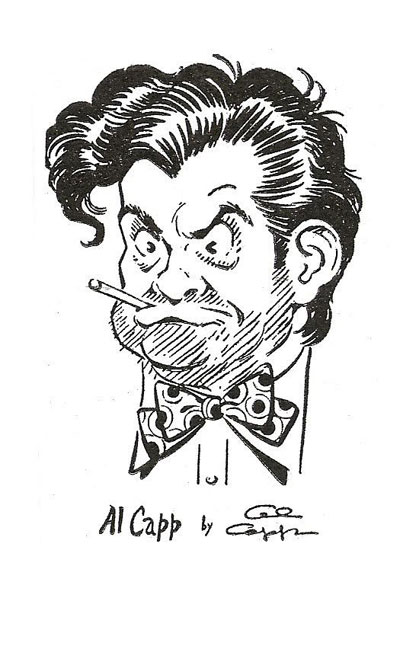
In the aftermath of his explosion in Editor & Publisher, Fisher didn’t produce the Confidential article. He didn’t unearth the Kahn’s New Yorker Profile. Nor did he find a transcript of the FCC hearing. He didn’t produce anything in his defense. That Fisher could have defended himself at least against the charge of doctoring Capp’s work is entirely possible. Assertions to the contrary notwithstanding, it is highly probable—indeed, likely to the point of certainty—that the so-called pornographic panels from Li’l Abner are, as Fisher claimed, Capp’s work. Certainly most of them are. With the reprint volumes from Kitchen Sink Press at hand, I compared panels reproduced in the Joint Committee’s report with the panels in the strips as they had been first published (see Cappendix). Wherever I found corresponding panels, they were identical. Clearly, Capp had drawn them.
I didn’t find corresponding panels for everything in the report. A few of the panels are probably from Sunday strips. The Kitchen Sink Press volumes do not include Sundays, so without a convenient way of discovering the “originals” of those panels, I could not compare the two. But it doesn’t matter: I found the originally published versions of most of the dubious pictures, and those that remain are in the same style and manner. Even if these had been tampered with, none of the others had not been. Fisher had evidence enough to support his accusations without having to forge any.
In their Capp biography, Schumacher and Kitchen agree that Capp drew the offending pictures albeit their assertion is considerably more circumspect than mine: “For discerning readers, including Fisher, Capp’s frequent visual and verbal double entendres were indisputable, but they were always clever enough to be ambiguous and thus fly below the radar of the vast majority of unassuming readers” (177). In support of this view, they reprint a couple of the tamer specimens, both of which I’ve included in the Cappendix.
The Ethics Committee almost certainly did not make the kind of comparison I did. By the time it met to consider the case, the strips at issue were not readily available for comparison
purposes: it had been five-to-nine years since they had been published in newspapers, and there was no ready access to strips that had been published so long ago. Besides, making such a comparison would have been pointless: most of the cartoonists doubtless recognized in the visual contrivances of the strips in question a kind of prankster spirit on the loose. They would scarcely be blind to what Capp was doing. Kahn wasn’t. And what Capp was doing—out there in the open—was hardly a secret. Not after Confidential. Not after The New Yorker Profile.
A few years ago, I talked with Beetle Bailey’s Mort Walker, who was on the Ethics Committee at the time of this incident. He confirmed my view that the Capp drawings had not been doctored—not in the usual sense. Fisher did not do his tampering with a pencil or pen; he did it with a pair of scissors. What he did, and it is readily apparent in a comparison of the strip’s published panels to those supplied to the Joint Committee, was to crop the panels in ways that focused attention on the lascivious parts of the drawings. The way Figure P in the Cappendix is cropped, for example, makes it appear that the woman is straddling the man in a posture of sexual intercourse. In many instances, Fisher did no cropping at all: isolating the panel was itself enough to draw attention to a nose that looked like a penis or a keychain (Figure H) that seemed to outline a penis. Fisher was undoubtedly innocent of any actual drawing; but Capp wasn’t.
Writing in The Comics Journal no. 147 (December 1991), comics scholar Martin Williams described in some detail the imagery with which Capp had infested his strip. Saying Capp was indulging “an obsession with what might be called visual double entendres,” Williams cited his evidence:
There were knotholes in his trees. By 1940 they were becoming more and more prevalent and more and more vaginal. Then there were abundant penis shapes. Once Available Jones and his erect dicknose had made its appearance, Capp seemed to go all out. Jones’ clef chin could be a scrotum from certain angles, and Capp became more and more fond of clef chins. He even gave occasional dicknoses to some of the more aggressive female characters, particularly around Sadie Hawkins Day.
Then there were the occasional droopydong noses of some of his aged males. And I have said nothing about the rectal mouths of Jeeter Blugg and his daughter, which go all the way back to 1938. Or the many, many times the number 69 came up in Li’l Abner. In my generation, all of us teenage boys knew what was going on at the time, and so did some of our girlfriends.
No, I didn’t say “phallic symbols.” These were phalluses, penises—dicks. The simplest Indian peasant woman, psychologist Carl Jung once remarked, knows the difference between a penis and a phallic symbol (even if Freud did not) (76).
But none of Capp’s playful porn was any longer at issue. By the time the Ethics Committee was deliberating in early 1955, the question of forgery was scarcely paramount. The important question was whether or not Fisher had circulated the strips, drawing attention to their salacious content. And his handwriting on the margins of the strips established to the Committee’s satisfaction that he had, indeed, distributed the incriminating material. In so doing, Fisher had delivered his colleagues into the hands of their enemies, the censorship forces then converging upon cartooning.
Fredric Wertham’s indictment of the comic book industry, Seduction of the Innocent, had been published the previous winter. An early missionary effort at indicting mass entertainment media as the source of most social ills, this incendiary diatribe claimed that reading comic books seduced young people into imitating the criminal behavior often depicted in the four-color pulp narratives, thus making comic books responsible for juvenile delinquency. In April 1954, the U.S. Senate Subcommittee to Investigate Juvenile Delinquency held hearings in New York to take testimony about the possible evil influence of comic books.
While the government eventually undertook no action against the comic book industry, the publishers themselves did. In September 1954, they formed the Comics Magazine Association of America, a watch-dog operation charged with seeing that its member publishers followed a code to which they all voluntarily subscribed. In addition to prohibiting such obvious affronts as using profanity in comic books, the Code forbade pictures of scantily clad women, excessive violence, anti-social behavior of all kinds, and even the use of the words “crime” and “horror” in comic book titles.
In this climate, syndicated newspaper cartoonists could be forgiven a certain measure of paranoia about their future. All of them already endured two levels of “prepublication review” for editorial approval with everything they did—first from their syndicate editors and then from the client newspaper editors—and they were understandably anxious about what additional restrictions might be imposed upon their creative efforts. In defending Capp by saying that the sexual content in his drawings was the work of a forger, Caniff and Raymond were defending themselves and their colleagues from the threat of additional “prepublication review,” a much larger issue than Capp’s perpetrating risque pranks. As representatives of their profession—and of the NCS—they would be expected to do no less, however much it may have strained their ethics.
Did they lie to protect their colleagues? At first blush, it would seem so. But careful inspection of their letters absolves them of that sin. Almost. The language of Caniff’s letter, which Raymond pretty obviously copied in his, is carefully contrived to be both condemnatory and accurate: he writes about distorting, contracting, and “withdrawing from context,” which is exactly what Fisher did. And Raymond, using some of the same expressions, added a few of his own, saying the Capp drawings had been “cropped, faked, wrongfully emphasized and twisted” to make them appear pornographic. In saying some of the pictures had been “faked,” Raymond may be crossing the line (although I suppose something could be “faked” without being “forged,” somehow), but neither Caniff nor Raymond asserted unequivocally that Fisher had redrawn or doctored the actual drawings. Not in so many words. A quibble of sophistry, no doubt; they came close enough to cast the necessary aspersions on Fisher. And their implications, without being outright falsehoods, effectively tainted Fisher’s reputation in the history of the medium. Despicably, Fisher had tried to destroy Capp’s professional standing and his livelihood; but he didn’t forge Li’l Abner drawings to do it.
Fisher’s effort to smear Capp amounted to a betrayal of his profession, and it was more for that than for the alleged forgeries that he was condemned and cast out of the Society. Considering that feeling among the cartoonists ran relentlessly against Fisher as a personality, the Society had been remarkably restrained in merely suspending him—and in giving him an indefinite period in which to respond and reclaim his standing in the membership. Whether
Fisher could eventually have done something to redeem himself is moot. At the end of the year, he was dead. By his own hand.
Weiss found the body.
Anyone with any psychological acumen might have seen it coming. In spite of his brave words, Fisher was devastated by the suspension. He had been publicly humiliated. He could no longer go about in society among the celebrities whose company was so vital to his sense of well-being. He disappeared from New York’s cafe society. He stayed to himself. He brooded.
Weiss recalled this period when we talked: “What happened was, he was coming over to the house to spend time with me—regularly—to tell me all his problems as well as his troubles because I think, most of the people didn’t want to listen to that anymore. We had a couple of kids, and I was doing the drawing, and he’d come over. And Blanche said to him one time, ‘Look, Ham, you’ve got to let Morris work.’ So that was it. Later, my neighbor across the street said he saw Ham’s Cadillac driving by. And later Ham said to me, ‘You know, I used to drive by your house and say, My friend lives there.’ So he had become a martyr now in the last part of his life.”
Weiss felt that the ouster from NCS was extreme. “There were highly regarded cartoonists then—like Bob Dunn, Ernie Bushmiller and so many of them—Otto Soglow—who wanted no part of Ham being expelled,” he told me. “They felt it was a feud between Ham and Capp and it should rest at that. And Capp was no knight in shining armor. But the Board of Governors made the decision; they decided to expel him. That I thought was pretty crumby. They should have consulted other people—Russell Patterson, Bushmiller, Dunn, and others who were very active in the Society—before taking such a drastic measure against a famous cartoonist. They could have said, ‘Look, if he broke the law and Capp wants to sue him, let him sue him. See if he wins.’ But Capp never sued him.”
Weiss related the sad final sequence of events to New York Daily News writer Jay Maeder, who rehearsed it in Hogan’s Alley no. 8 (Fall 2000). Fisher visited Weiss at his New Jersey home the Friday before Christmas in 1955, distraught as usual. He often phoned Weiss, begging him “to drop everything and immediately join him for dinner because he was terrified to be alone with himself,” Maeder wrote (89). Weiss was a patient listener most of the time, and Fisher needed someone to pour out his troubles to.
Soon enough over coffee and cake Fisher lapsed into the old familiar self-pity, wailing again that his new young wife is leaving him, that his studio assistant Moe Leff is openly sneering at him, plotting against him, making him crazy ... and ... and ... oh, God, Weiss has heard it all before so many times.
As he left Weiss’s home, Fisher pleaded: “Please come to work for me,” he said.
“No,” Weiss said. But he knew that wouldn’t be the end of it.
Fisher phoned three days later, on Monday after Christmas. Again, he begged Weiss to come and work for him. But Weiss’s drawingboard was piled with satisfying bread-and-butter jobs, and he had no time for another of Fisher’s self-pitying tirades.
“Help me,” Fisher entreats Weiss.
“No,” Weiss says firmly.
Fisher is blubbering now.
“Look, I can get you an artist,” Weiss snaps. “But do something. Fire Moe, get a divorce, give up the strip, sell it. Ham, I don’t want to hear anything else from you until you do something concrete.”
After all these years, Morris Weiss is at last at the end of his rope.
“Do something!” he shouts into the phone.
“Help me,” Fisher begs.
“Help yourself,” Weiss says.
There is a moment of silence.
“I will,” Fisher whispers. “I will tomorrow. God love you,” he finishes, and the line goes dead (89).
The next day—on the afternoon of December 27—Weiss received a phone call from Fisher’s young wife, Marilyn (nee Franklin). Married to Fisher only a year, she was alarmed because she couldn’t raise her husband at the studio. She called Weiss several times that afternoon. Finally, Weiss sighed and set out for Manhattan. He went to Moe Leff’s studio. Fisher had been using the studio while Leff was out-of-town. Persuading a janitor to let him in, Weiss saw Fisher prone on the daybed, an empty bottle of pills nearby. Fisher was dead. In two notes Weiss found near the body, Fisher had written that he was despondent about his health (he had diabetes and his eyesight was beginning to fail) and that he intended to take an overdose of some pills he had been using. “God will forgive me,” he wrote, “for I have provided for my family.” (Chiefly, in addition to Marilyn, his daughter, Wendy, the product of his first marriage to Carolyn Graham.)
Weiss cursed softly and phoned the Daily Mirror, the New York newspaper that had carried Joe Palooka from the beginning. He felt Fisher would want his flagship client to get the news first. Then he phoned the police. Then he phoned his wife to say he’d be late getting back home. And finally, he phoned Marilyn.
As soon as Milton Caniff heard the news of Fisher’s suicide, he thought of Capp. “I called his house in Boston,” he told me. “His kids were still at home then, and his daughter answered the phone. Al was out. And she said, ‘Any message?’ So I said, ‘Ham Fisher is
dead.’ And she said, ‘Who did it?’ Didn’t ask how he died—she said, ‘Who did it?’ He was that cordially disliked.”
And Capp was no prince either. Maeder describes a bizarre incident in the aftermath. Lee Falk, who wrote The Phantom and Mandrake the Magician, told Maeder that he ran into Capp at the bar in Sardi’s shortly after Fisher’s funeral.
The two comics men talked shop for a while, and eventually the conversation turned to the recent sorry demise of the man who had created Joe Palooka.
Capp laughed the harsh laugh of the victor. “Ennobled it,” he said. “He has ennobled our feud.”
Capp turned to address the entire room. “He ennobled it,” he brayed. “It is a noble thing he did.”
Falk stared into his glass. My God, he said to himself—the man thinks this is Tristan and Isolde.
Chapter Seven
BUT CAPP WAS NOT FINISHED. In the fall of 1956, eight months after Fisher’s suicide, Al Capp took up the question that the Fisher episode had left hanging over his head. He wrote to Caniff, who was still chair of the Ethics Committee:
Coming back from Alex Raymond’s funeral the other day [Raymond died September 6, 1956], I thought that most of us, as he did, leave so many questions in our lives unresolved from day to day, never knowing when the last day will come, and the chance forever gone.
Fisher’s suicide left the most important issue of my career unresolved. It prevented the National Cartoonists Society from performing its final honorable act—the expulsion of that poor criminal for the criminal forgeries of my work, an act that brought dishonor for a while on my career (and on all of us, actually).
With the FCC business ended and Fisher gone, the final act of the Society—to say plainly what its findings were and to say plainly that the stigma attached to my work by one of its members was a crime against the Society and against me—has one value and that is that my kids, and my grandchildren, will know that I was an honorable man and no discredit to my profession.
Can I ask you, as a member of the Board, to propose that a final finding be written on this matter. It means a lot to me, as every one of you will understand (undated copy of letter).
Caniff promised to bring the matter to the Board: “I will be glad to propose that a final finding be written on this matter and do all I can to bring it about,” he wrote Capp on September 19, 1956. Caniff approached Walt Kelly, still NCS president, and Kelly consulted the Board, which decided that Kelly should respond by saying that the Board considered the matter closed and would take no further action on the issue.
Capp moved on.
Not content with the outlet Li’l Abner afforded him, Capp had branched out into other venues all through his career. In 1937, he had launched another comic strip, a somewhat more serious narrative about a crusty old spinster and her manly nephew called Abbie and Slats, which he wrote and Raeburn Van Buren drew; after nine years, Capp’s brother Elliott took over the
scripting, continuing until the strip ceased in 1971. And in 1954, Capp started writing yet another strip, Long Sam, starring a female version of Li’l Abner; drawn by Bob Lubbers, it ran until 1962.
Capp’s creations ventured beyond newsprint, too. An RKO movie adaptation, “Li’l Abner,” had appeared in 1940, but Li’l Abner was a bigger success on stage in live theater with a Broadway musical that ran for 693 performances, starting in November 1956; it was turned into a motion picture at Paramount in 1959. And there was an amusement park, Dogpatch U.S.A., and a fast-food chain.
A master at creating publicity about himself and his strip, Capp enjoyed a second albeit simultaneous career as an after-dinner speaker and newspaper columnist, leaving most of the drawing on the strip to his assistants while he concentrated on writing the scripts. Capp was also a frequent guest on radio and television talk shows, regaling his audiences with his analyses of
contemporary events, outrageous commentaries which he punctuated with his characteristic jubilant hoots of self-appreciative laughter.
In the 1960s, his target was often student protest against the Vietnam War: in the strip, college youths were all members of S.W.I.N.E., “Students Wildly Indignant about Nearly Everything.” Touring college campuses as a speaker, Capp was on a crusade against what he saw as morally bankrupt youth. He seemingly delighted at the outrage he provoked among the students in his audience with such pronouncements as:
“Colleges today are filled with Fagin professors who don’t teach; they just corrupt.”
“President Nixon showed angelic restraint when he called college students bums.”
“Princeton,” he told the student body at Princeton, “has sunk to a moral level that a chimpanzee can live with, but only a chimpanzee. It has become a combination playpen and pigpen because it disregards the inferiority of the college student to every other class.”
Capp was having great fun, but he was roundly criticized by his traditional constituency of liberals for the unyielding rigor of his attacks on the New Left. It was assumed that Capp had defected and gone over to the Right. But Capp’s objective as a satirist remained constant: the fanaticism of the New Left was no less a human folly in his eyes than the rigidity of the Old Right in seeking to preserve the venerated conventions of its social order. Capp took folly where he found it and unceremoniously ripped the veils of self-righteousness away, roaring with Rabelaisian laughter all the while.
“The strip was about the way the powerful use power—and abuse the powerless,” Capp told William Furlong (148). “The possession of power must never be accepted as deserved or unarguable,” he continued, “—you must always remain skeptical.”And in the 1960s, the power changed hands, passing from the establishment to the shriekingly vocal anti-establishment. So Capp changed targets, telling Rick Marschall:
“My politics didn’t change. I’ve always been for those who are being shamed, disgraced, and ignored by other people,” Capp said. “Now it’s the poor bastard who works who is being denounced by the liberals. For chrissakes, these working stiffs are keeping the country afloat. They were denounced, and it got me damn mad” (15).
On another occasion, Capp said: “A satirist has only one gift: he sees where the fraud and fakery are. I turned around and let the other side have it.”
In a letter to Time published in the April 18, 1969 issue, Capp said: “The students I blast are not the dissenters but the destroyers—the less than 4% who lock up deans in washrooms, who burn manuscripts of unpublished books, who make combination pigpens and playpens of their universities. The remaining 96% detest them as heartily as I do.”
As Capp saw the New “Student” Left—the 4%—they were making a cult of their dissatisfaction, Furlong said, quoting Capp:
“There’s an ugliness in American life today—you see it in the way some of the kids dress, the way some of them act. Somehow in the effort to atone for the ghetto, they’ve turned the whole world into a ghetto. I think this generation has made everything as ugly as the ghettos I lived in—not out of sympathy but as a form of punishment.”
He suggests that the cultists preach love but act out hate—that they “are using the people trapped in the ghetto to build hate for other people. They’re telling us, they’re telling them, ‘Hate and despise your neighbor and you’ll elevate yourself.’ But I grew up in a ghetto, a poorer one than most of these kids have ever seen, and I know the people in the ghetto aren’t as much interested in hating those who live better lives as in joining them” (149).
And Capp did more than rail at these malcontents, Furlong says: he used some of the money he got from lecturing on campuses to send ghetto kids to college—as he had his own brothers.
Then in April 1971, the merry-go-round stopped. On the campus of the University of Wisconsin - Eau Claire, a young married co-ed blew the whistle on Capp, accusing him of sexually assaulting to her in his motel room. The co-ed’s story was that she’d gone to Capp’s room at his request to talk with him about the political climate on campus as preparation for his talk. Then he exposed himself to her, made suggestive comments and attacked her. Caniff believed that the co-ed and her radical friends had set a trap for Capp, hoping to disgrace the despised but articulate foe of the New Student Left.
That may have been the case in Eau Claire, but after that incident, others surfaced. In 1968, Capp had been asked to leave town by University of Alabama officials, acting on the complaints of four co-eds. By 1971, the cartoonist was under investigation on similar charges at other colleges.
Although out of loyalty and friendship, Caniff contended that Capp had been the victim in the incident, at the very same time, he strongly suspected that Capp was guilty as charged. His mistake, Caniff believed, had been in approaching “amateurs.”
“Al was down in New York every week and sometimes for weeks at a time, having his fun,” he told me. “He had some good lookin’ broads, believe me. They all flocked to him, thinking that he could do them some good in their careers. He seldom got caught because he didn’t have anything to do with amateurs: the women he squired around town here were obviously gals on the make—showgirl types, gals who wanted to be seen with celebrities. The old badger game he fell into in Wisconsin could have happened only in a place like Wisconsin—not around New York City.”
As soon as he heard of the Wisconsin co-ed’s charges, Caniff fired off a telegram to his old friend. Just four words: “Who do we slug?”
“It was just what he needed,” Caniff remembered. “He wrote me a long letter about that little telegram, about the impact the incident had on him and everybody around him. It rocked him much more so than he ever would have admitted. Al had a strangely naive attitude about himself: he thought he could come down here to New York and play around with these babes and no one would say anything. Once when a gossip column mentioned his being seen with Miss Hootenanny or some such, he was shocked. He thought the ‘boys’ would protect him. He thought the Winchells and all the others would—out of professional courtesy—not mention anything. But those guys would turn on their own mothers. So it got to be sticky: Catherine also read the papers. Everyone just kind of avoided the subject.”
But there was no avoiding the fallout from Eau Claire. Syndicated columnist Jack Anderson published a column on April 22, about three weeks after the Eau Claire affair, that detailed the episode at the University of Alabama. Writing later about Capp’s campus peccadilloes in his book Inside Story, Brit Hume said he did all the legwork on the Anderson piece not knowing about the Wisconsin incident. A conservative of the religious right persuasion, Hume was enraged by Capp’s reported conduct in Alabama. He also recognized the deliciously scandalous irony in the situation: all the time Capp was rampaging against the lax morality of the Student Left, he was “a goddam sex criminal,” attempting rape (75). Hume was gratified that the April 22 column persuaded the Eau Claire co-ed that she was not alone, so she pressed charges.
The Eau Claire district attorney charged Capp with indecent exposure, attempted adultery and attempted sodomy (oral sex). Formal charges of indecent exposure and attempted sodomy were subsequently dropped when Capp agreed to plead guilty to attempted adultery. The D.A. subsequently amended Capp’s guilty plea to nolo contendre (no contest) when Capp said that he would end his lecture tours and never again appear on a college campus.
Eventually, it emerged that Capp’s behavior in Eau Claire and Tuscaloosa was typical of him rather than unusual. Hume reports getting several letters and phone calls from young women who had experienced Capp’s crude advances as early as 1967. In the January 1985 issue of Playboy, Goldie Hawn told about Capp’s propositioning her in his hotel room in New York when she was an unknown actress looking for a career.
Newspapers began canceling Li’l Abner, and Capp was no longer invited to appear on tv talk shows. Capp was also ill, suffering from emphysema, which was getting worse as he continued his daily cigarette consumption. “I enjoy smoking more than breathing,” he quipped to Marschall (11). By the fall of 1977, he knew he was no longer up to the task for doing a daily comic strip. And he knew the quality of Li’l Abner had slipped.
“If you have any sense of humor about your strip,” he said, quoted in Time’s obituary, “and I had a sense of humor about Abner, you knew that for three or four years Abner was wrong. Oh, hell—it’s like a fighter retiring. I stayed on longer than I should have.”
He toyed, briefly, with the idea of passing his burlesque bumpkin on to another, younger, cartoonist. “I thought about ghosts,” he said to Marschall, “but I said—screw it: I’m not going to give Abner to some kid to change. Let him do his own stuff while we bury Abner honorably” (15).
He discontinued the strip that fall: the dailies with the November 5 release; Sundays, a week later on November 13. Li’l Abner was then being published in fewer than 400 newspapers, less than half its peak circulation
“It would have been nice,” Capp said, with a sentimental flourish, “to include a final note on the last strip: on Monday, this space will be occupied by a fresh new cartoonist.”
Exactly two years later, on November 5, 1979, Capp died after a long illness complicated by emphysema. It was sad, Caniff said; but he and his wife Bunny had also felt a sense of relief, he told me: the ordeal for Capp’s wife Catherine was now over.
Chapter Eight
BUT IT WAS FISHER’S REPUTATION THAT WAS OBLITERATED. It is still bruited about among cartoonists, for instance, that he couldn’t draw. And I’ve seen evidence to the contrary—including photographs of him doing chalktalks at which it would be impossible to fake drawing ability.
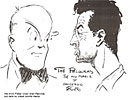 |
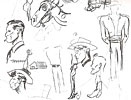 |
 |
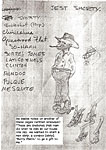 |
Even if my bald-faced assertion is suspect—since I didn’t actually see Fisher draw the pictures attributed to him—the logic of the contention that he couldn’t draw is internally flawed. And the flaws reveal the falsity of the allegation. If he couldn’t draw, how could his colleagues determine he had doctored the panels from Li’l Abner? And if he couldn’t draw, the anecdote about the beautiful blonde wanting his autograph and being disappointed when she realized he wasn’t Al Capp is a fabrication: a key aspect of the story is Fisher drawing a picture of Joe Palooka right there, on the spot.
But Fisher simply disappeared, faded into the dimly recalled corridors of cartooning lore, his achievements becoming faint as they retreated into the darkening distant hallways of the past until, like Lewis Carroll’s famous grinning cat, only a shadow remains behind, albeit a substantial shadow—a ten-ton statue of Joe Palooka in Bedford, Indiana, carved in 1948 as part of the Indiana Limestone Centennial—but a completely irrelevant remnant.
No one decided to deny Ham Fisher a place in the history of cartooning. The profession’s odd silence on the subject is not the result of deliberation and design. It is instead an accident, an unforeseen constellation of circumstances, a happenstance of personality and event, which, invested with pride and ego and jealousy and vaulting aspiration, turned ugly. The tragic end of the Fisher-Capp feud could well promote vague feelings of shame and guilt among those who stood by, feelings that were suppressed by keeping silent. Fisher’s suicide was a blot on the escutcheon of the National Cartoonists Society. And it is therefore understandable if many cartoonists fell into the habit of not mentioning it. And by avoiding the subject of Fisher’s death, the subject of his attainments is likewise shunted out of view.
And while I’m delving into unconscious motivations, let me toy with one more fanciful speculation. This time, on the matter of Fisher’s motives.
Fisher’s behavior strikes me as more than a little extreme. Capp’s appropriation of hillbilly characters for a comic strip doesn’t seem to me sufficient provocation for Fisher’s subsequent actions—the tirades, the smear campaign. Psychologically speaking, when someone’s behavior is excessive for the provocation, it suggests that the presumed motivation is not, in fact, the real reason for the reaction we see. And when this happens, it’s because the real reason must not be consciously acknowledged. It must remain a secret, buried in the subconsious.
And exactly that, I think, is what lies beneath the famous feud.
Fisher accused Capp of stealing his hillbilly idea, but there is virtually no substantial similarity between Capp’s Yokums and the family of Big Leviticus in Fisher’s strip. Both families are hillbillies, and both are, by sophisticated big city standards, stupid; but there the resemblance ends. The Yokums are absolutely good; Big Leviticus and his relatives are mean.
Fisher could scarcely claim Li’l Abner is Big Leviticus.
We could make the case that Big Leviticus and his family are reincarnated in Li’l Abner as the infamously depraved Scragg family. But with the Scraggs, Capp exceeded anything Fisher could have imagined. The Scraggs are absolutely a-moral monsters, killing and maiming their way to their objectives, whatever they may be. Big Leviticus was mean, an all-purpose bully; but he wasn’t monstrous. Besides, Big Leviticus made only occasional appearances in Joe Palooka; and likewise, the Scraggs in Li’l Abner. Neither Leviticus nor the Scraggs were so conspicuous as to constitute the reason for either strip’s success. Both sets of characters were, in fact, minor figures in the casts of the two strips. In short, the Scraggs could not have been so constant a reminder as to be an ever-present irritant to Fisher. And Fisher’s behavior is that of a man constantly plagued with an annoyance that wouldn’t go away.
The explanation for his behavior, it seems to me, is this: on the unconscious level, Fisher didn’t believe Capp stole hillbillies from him; he believed Capp stole Joe Palooka.
The heroes of both comic strips are big strong hulks and a little slow witted. I don’t mean that Joe Palooka was ever as stupid as Li’l Abner. But the early Joe was so naive, so innocent of the world, that he seemed stupid. Like Li’l Abner, Joe came from a small town environment in rural America. As in Capp’s strip, some of Joe’s earliest predicaments were caused by his innocent inability to understand the more sophisticated world in which he found himself. (Palooka’s first fight is a perfect example of exactly this aspect of his character.) Joe usually wins in these situations: his essential goodness triumphs, an affirmation of virtue.
In Li’l Abner, we have pure stupidity firmly ensconced in place of naive innocence. But the flywheel of the strip’s dynamic is the same: stupidity and innocence are interchangeable as plot devices. For all his stupidity, Li’l Abner is as fundamentally good as Joe Palooka; in fact, Abner could be seen as a parody of Palooka.
Capp’s satire unquestionably ridiculed everything that Fisher believed in—the triumph of virtue, goodness, purity, and wholesomeness. The good characters in Li’l Abner do not so much win as they simply survive. Mammy Yokum is the exception. When she becomes engaged, she wins. But the other Yokums are perpetual victims. They are resilient rather than victorious. They are good people, but they don’t survive by being virtuous as Joe Palooka does. They survive because the forces opposing them destroy themselves with conflicting venal motives.
The lesson of Fisher’s strip is that virtue will prevail. The lesson of Capp’s strip is that evil will prevail but that goodness will somehow survive. His strip was the cynical response to Fisher’s strip. Li’l Abner was almost a lampoon of Joe Palooka, as I said. But I don’t think Capp had gentle Joe in mind as a specific target. The target of Capp’s parody is all of misguided human kind, the people who believed in what Fisher believed in. No wonder Fisher was so continually enraged by Capp.
So why didn’t Fisher say that Capp stole Joe? Partly because on the conscious level, Fisher didn’t fully comprehend what he perceived on the unconscious level.
Partly because asserting the theft would proclaim the parody, making Fisher’s achievement overtly the butt of the joke. But there is more to it than that.
Eventually, Joe Palooka got smarter. By the end of the 1930s, he was an inspirational figure. He became more sophisticated. He lost his innocence. And in place of innocence, Fisher substituted goodness, pure and simple.
If Fisher were to have claimed that Capp copied Joe Palooka in creating Li’l Abner, he would have reminded everyone that his Kindly Gracious Knight was once as naive as Li’l Abner was stupid. In fact, to all intents and purposes, Fisher would have been confessing that Joe Palooka was once a stupid hick. And that admission would have sullied the image Fisher had so carefully constructed for his champion.
Consciously, Fisher undoubtedly did not realize any of this. But on the unconscious level, Fisher knew it with certainty. And rather than risk undermining Joe’s image, Fisher shifted attention away from Joe and Li’l Abner to hillbillies in general. But he could not divert the vehemence of his outrage at Capp’s having stolen his hero in order to ridicule everything he believed in. And so the accusation about the theft of the hillbilly motif became unconsciously invested with psychic energy drawn from the real cause of Fisher’s anger, Capp’s parodic ridicule of Joe Palooka’s triumphant goodness.
That source of energy fueled Fisher’s rage until it became fuming hatred. And Fisher could incorporate into his personal motivation a larger, social mission. To the superpatriot Fisher, champion of traditional American values, Capp’s satirical crusade (not to mention his subliminal sexual innuendoes) seemed bent on corrupting conventional morality; Fisher had to stop it. And so, desperate, he resorted to the smear tactics that eventually led to his ouster from NCS and, perhaps, to his own death.
Fisher had demonstrated jealousy about rival characters before, very early in the run of Joe Palooka. Weiss told me of Fisher’s concern about Mickey Finn: “When I started working with Lank Leonard in 1936, it was the same syndicate as Joe Palooka, and Ham was rather upset at the syndicate’s taking on another character whose personality was similar to Palooka. Mickey Finn was a nice Irish cop but very naive. Lank Leonard had to go in to get together in a conference with Ham and Charlie McAdam to make sure where he was going with Mickey Finn. Mickey Finn was going to be a wrestler at one time.”
Here Fisher revealed a conscious concern with roots in the competitive nature of the marketplace for comic strips; with Li’l Abner, if my speculation is accurate, his preoccupation had a much more insidious origin.
There was nothing furtive, however, about the attitudes of the two feuding cartoonists towards their creations. Capp always spoke disparagingly about Li’l Abner, habitually calling him a stupid lout. He seemed to have a very low opinion of his protagonist. On the other hand, Fisher admired Joe Palooka. He loved him. But Fisher had no friends.
--oo0oo–
CAPPENDIX
HERE ARE THE IMAGES taken from the report of the New York State Legislative Joint Committee on the Comics compared to the same panels as they appeared in the Kitchen Sink reprints of Li’l Abner. The blurriest images are from the report; they are blurred because the report copied in black-and-white panels from color comics, not the best way to produce clear images. The clear images are photocopied from the black-and-white Kitchen Sink reprint volumes, which reproduce the strips as they were published in newspapers throughout the country. Corresponding images are identified by letter, A through P. The object of the comparison is to establish beyond doubt that the offensive images that had been sent to the Joint Committee were the same as the images in the published strips, images drawn by Capp or his assistants (with Capp’s approval, surely). After the images comes the three-age letter detailing NCS’s charges against Fisher.
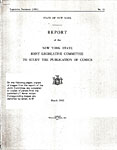 |
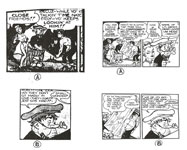 |
 |
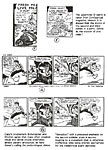 |
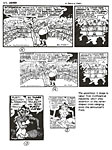 |
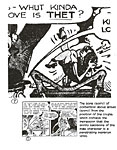 |
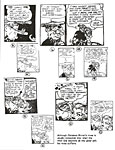 |
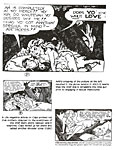 |
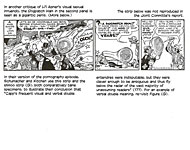 |
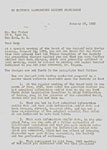 |
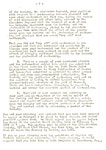 |
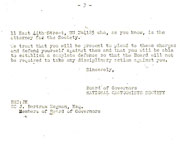 |
CAPP - FISHER SCRAPBOOK
IN ADDITION TO A COUPLE OF SCRAPS from the works of the two cartoonists, this scrapbook offers autobiographical comic strips by each of the cartoonists and summaries of the continuities of the two comic strips. First Fisher; then Capp.
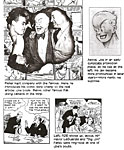 |
 |
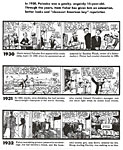 |
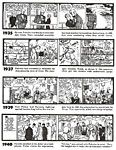 |
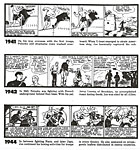 |
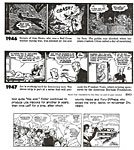 |
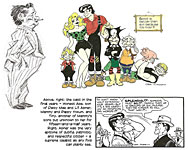 |
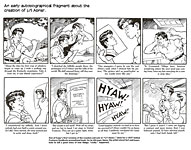 |
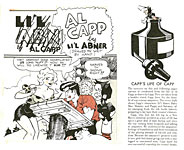 |
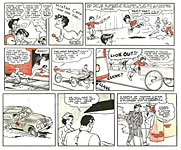 |
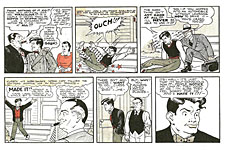 |
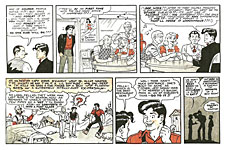 |
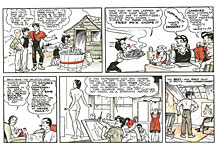 |
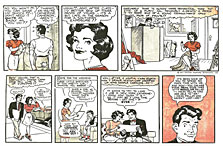 |
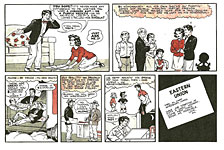 |
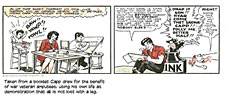 |
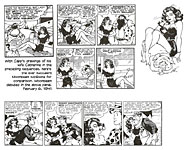 |
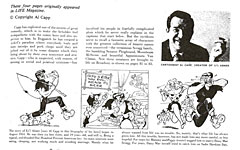 |
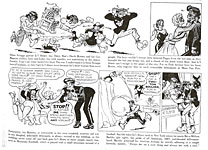 |
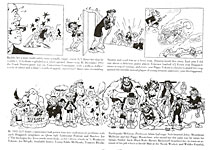 |
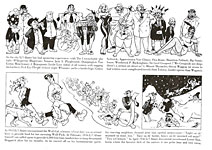 |
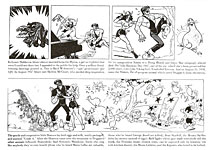 |
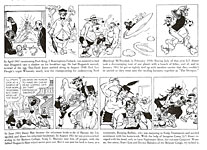 |
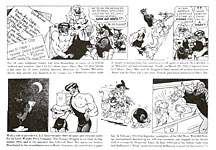 |
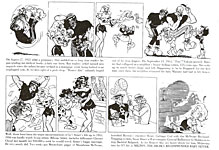 |
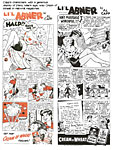 |
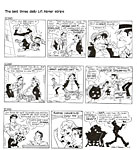 |
